



This family-friendly ‘Albion’ style fair for Finsbury Park’s 150th anniversary forms part of our 3-year programme Citizen Sci-Fi – crowdsourcing creative and technological visions of our communities and public spaces, together.
Music, storytelling, costumes, food, and all kinds of activities for exploring the future of the park and beyond!
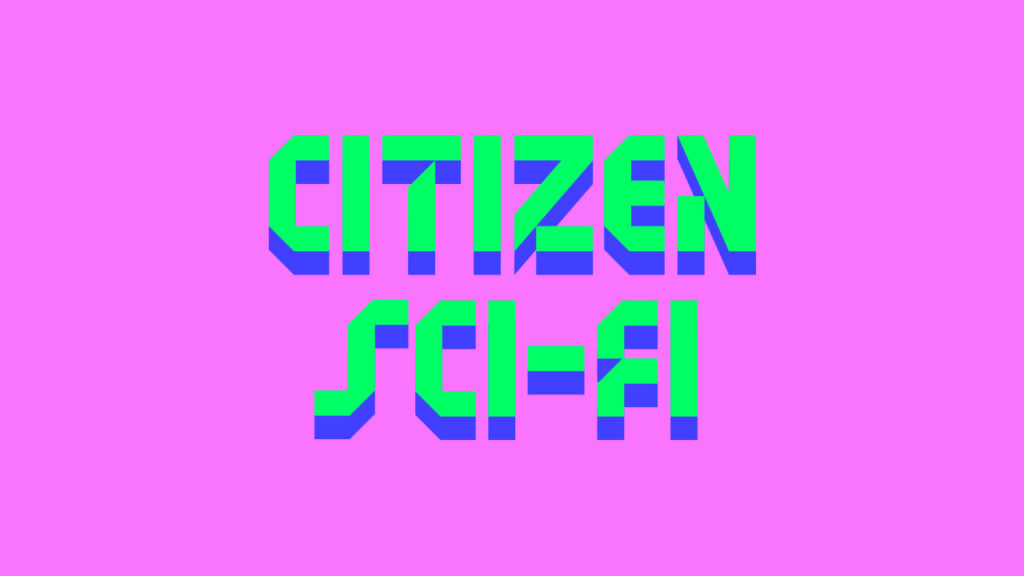
Activities Include:
Martin Zeilinger
Should a cashless society leave us quaking in our boots? Come play our game imagining the future of money – and how we’ll get by if there’s no cash to pay for things. You’ll get given a scenario and asked to design a way to make exchanges in the future. Are you a ‘Barter Bender’ or ‘Sharey Carey’? Or will you sink the system and start again? Find out!
Times: 10.00-5.00
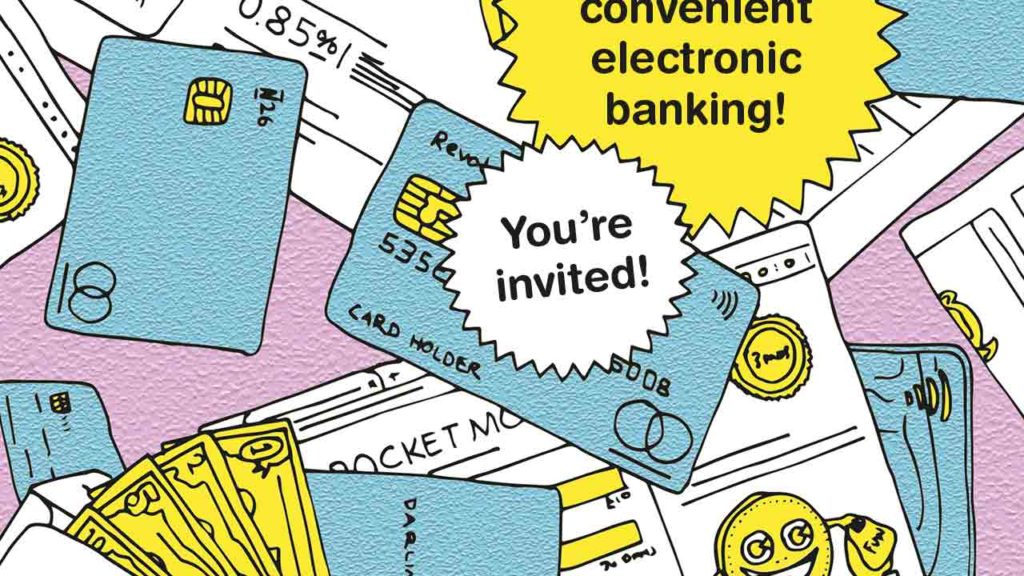
Mud Howard and Stephen Oram
Gather round and listen to two short stories emerging from the heady mix of sci-fi authors, scientists and the folk of Finsbury Park. Come and decide if these are the futures you want for your park?
Times: 11.30, 2.30
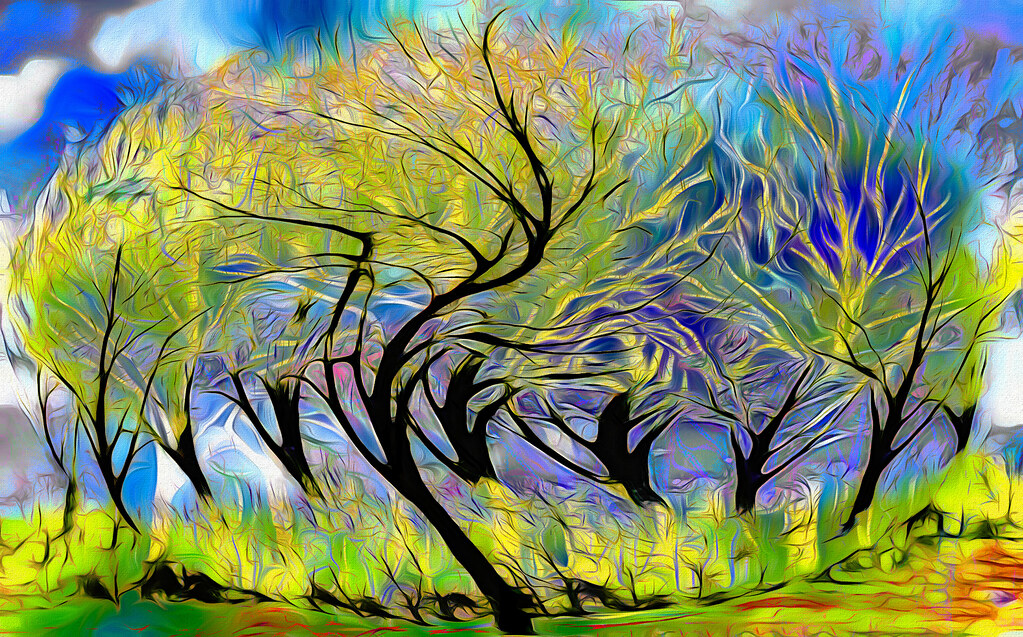
Idit Nathan and Helen Stratford
Take part in the launch of an entirely new app that leads you on a walk of the park that’s like no park walk you’ve ever been on before! This app was designed with local people through similarly silly strolls and we need YOU to bring it to life! Drop by and we’ll show you how to download the app (it’s very easy!) and collect a map that will help you ‘catch’ prompts all around the park. We’ll also have colourful badges for you to take home.
Times: 10.00-5.00
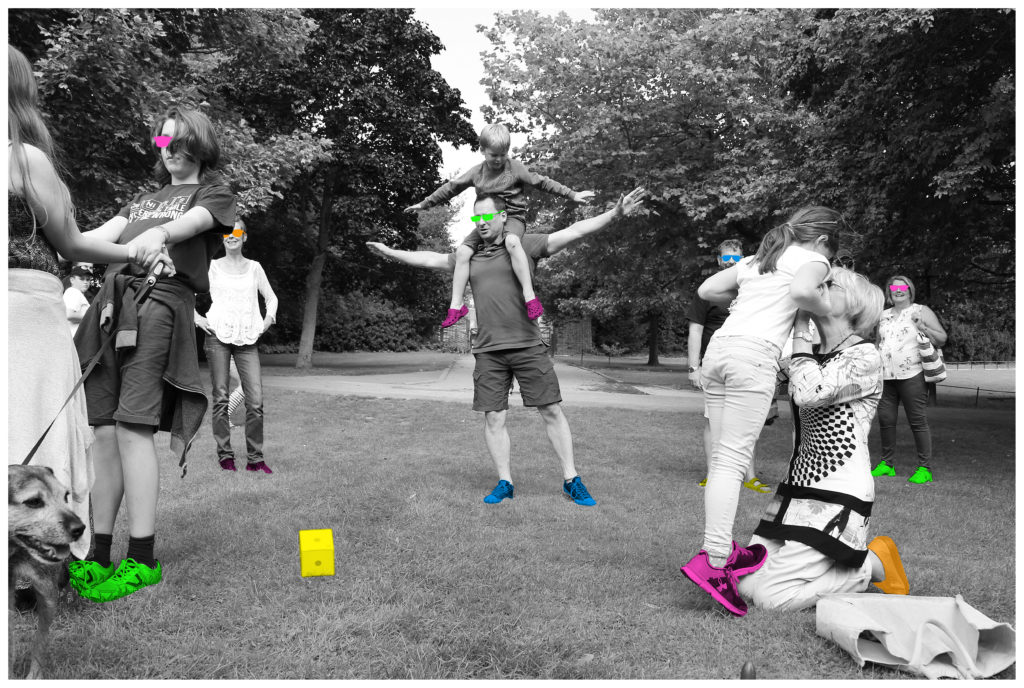
Jason Wilsher-Mills
Pedal Power, come meet Jason and the Argonauts – a set of wild and wacky AR-enabled characters who have come to visit you. Jason will show you how he made them and how you can help him make new ones all about the Pedal Power community. (this activity is especially for Pedal Power, but all welcome)
Times: 10.00-5.00
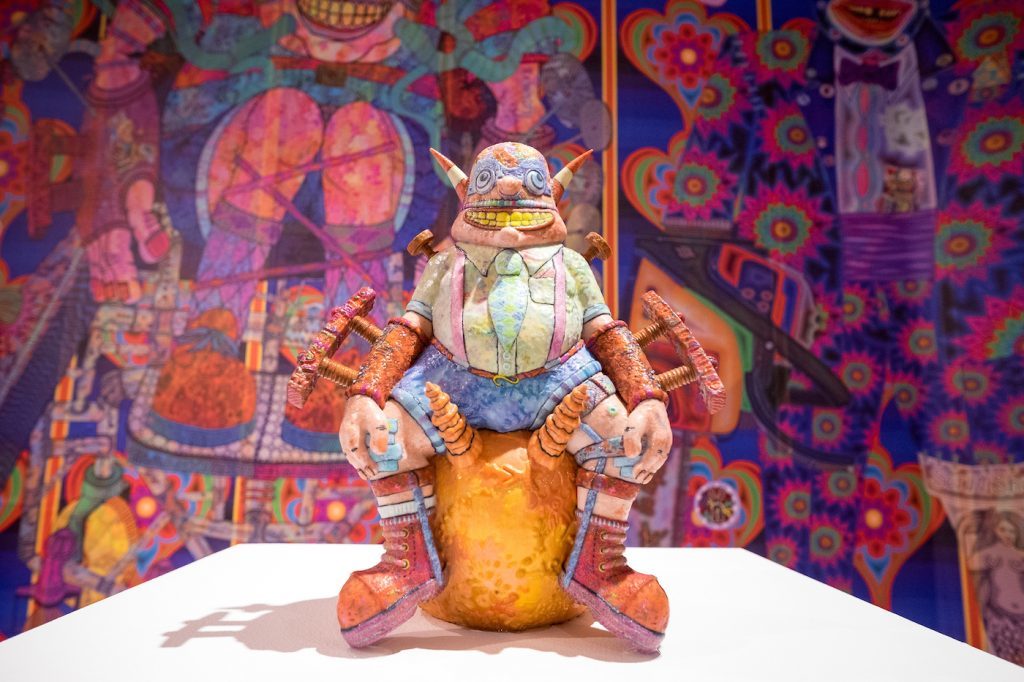
Alex Dayo
Drop by and join in a family-friendly Community Drumming workshop led by Alex Dayo, master drummer from Burkina Faso (West Africa), find your inner rhythm and let it out!
Times: 10.30, 4.00
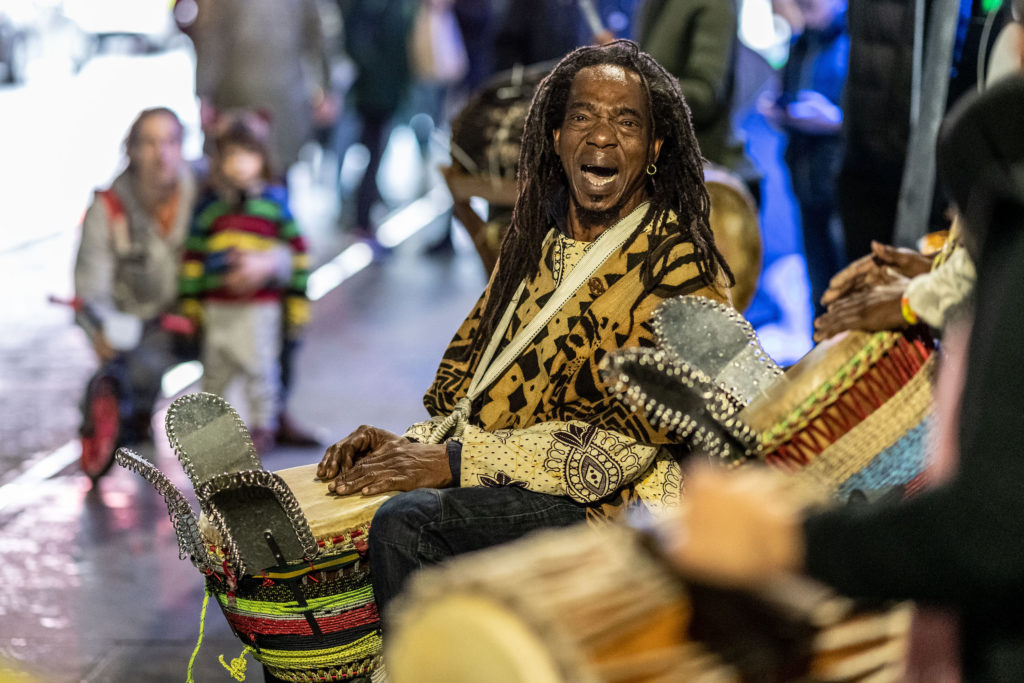
Possible Bodies: The Underground Division – Helen Pritchard, Jara Rocha, Femke Snelting
Join a research session with Possible Bodies: The Underground Division, a team of fiction writers, geo-techno-scientists and trans*feminist device problematizers. A hands-on collective investigation into the micro, meso and macro political consequences of earth scanning practices. Together we’ll look at what undergrounds are rendered when using techniques such as Terrestrial Light Detection and Ranging, magnetic resonance, UltraSound, and Computer Tomography.
Times: All day but limited places, book now

Feminist Internet
What have parks done for their communities? What role do they play in our lives both socially and politically? What kind of spaces could they be for us in the future? Feminist Internet launch a special episode of their podcast series and an accompanying zine for the Albion fair that unearths the history of Finsbury Park, examining the role urban parks play within their communities and speculates about their potential futures.
Times: 10.00-5.00
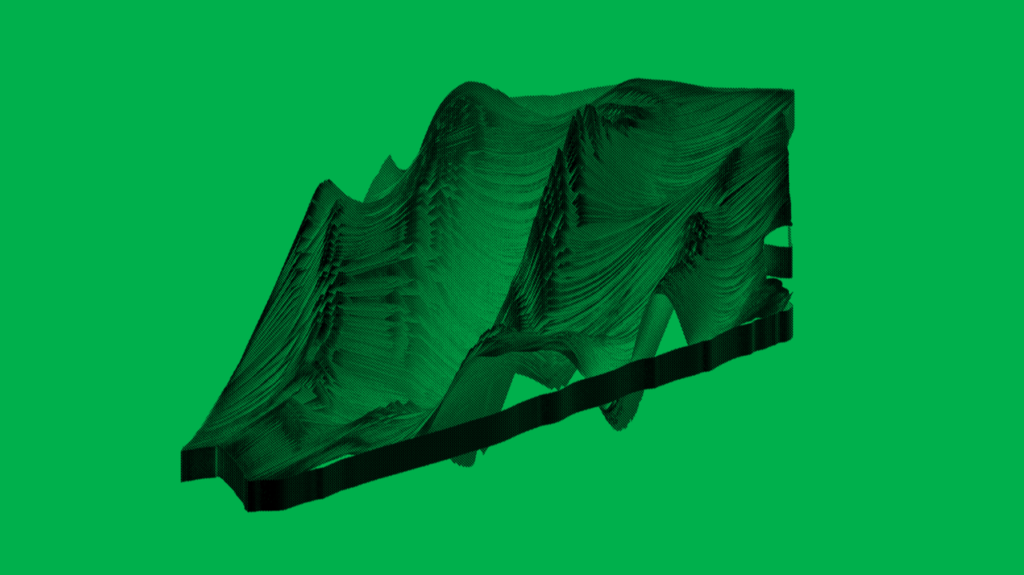
Larisa Blazic
It’s time to call this meeting to order! Join a special Theatre of the Oppressed inspired performance by reading aloud meeting minutes published by Finsbury Park’s many organisations and community hubs.
Times: 12.00-2.30
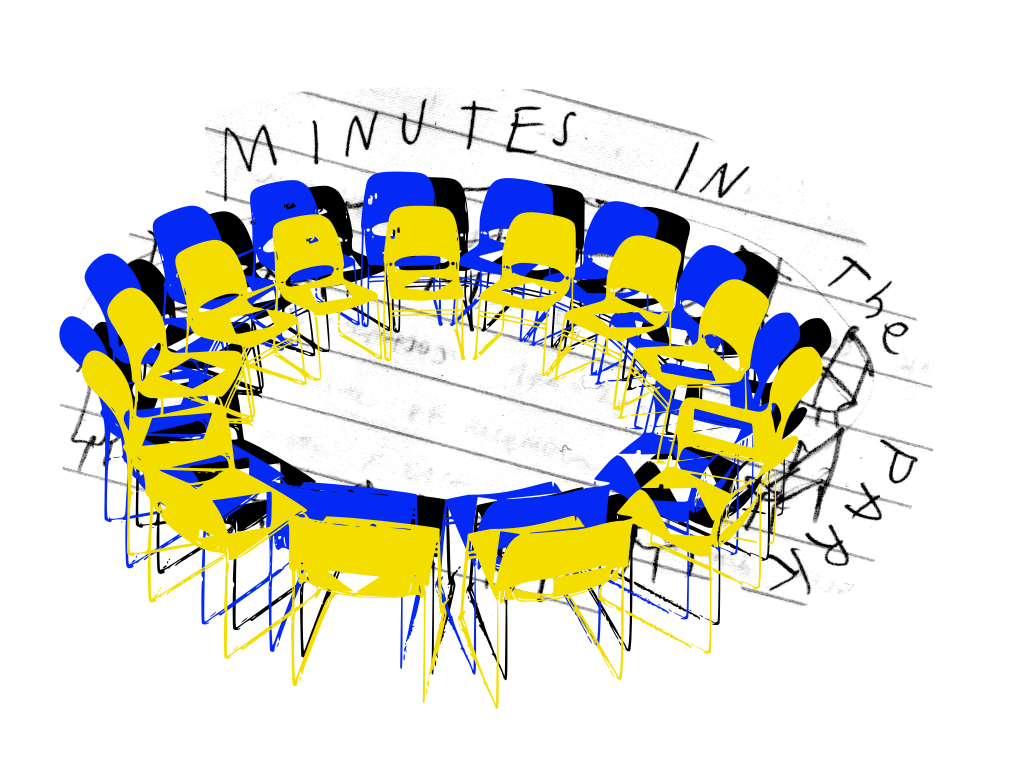
Sunara Begum
The ‘Who Am I?’ workshop is about reversing technology and reflecting on history through creativity. Design and create your own special crest and emblem to signify who you are. Investigate the world of sound through percussion-led music making and immerse yourself in the art of expression through movement. The workshop looks at understanding who we are, tapping into our inner self, asking questions, seeking answers and sharing personal and collective journeys.
Times: 10.00-5.00
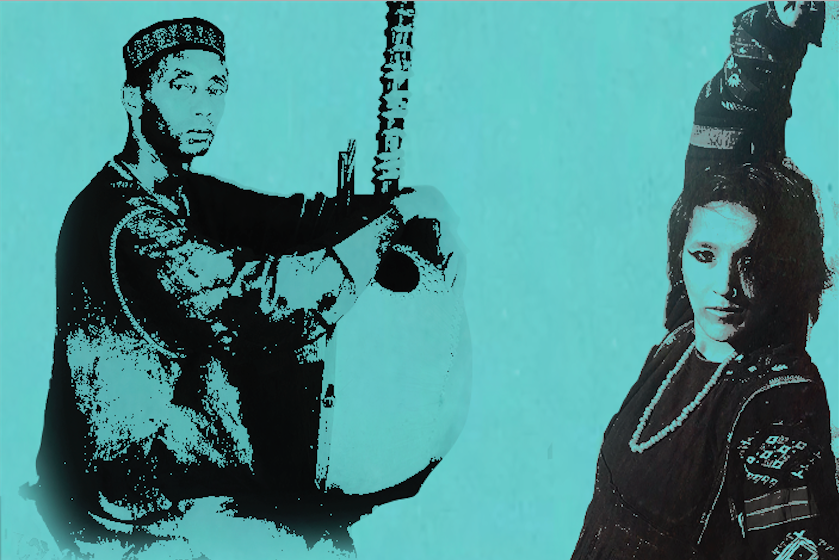
Artist: Alistair Gentry. Curators: Hannah Redler Hawes and Julie Freeman.
Just how trusting are you? Meet the hot-pink puppet-robot who wants to tell you all about your life online! How much will you reveal and how much does the trustbot know already?
Times: 10.00-11.30, 12.00-2.00, 3.00-5.00
This work was produced as part of an ODI R&D project funded by Innovate UK.

Rachel Jacobs
How will you dress fancy for the Future Machine? Rachel Jacobs needs your help to create a stylish parade for the unveiling of the Future Machine this autumn. What will you wear?
Times: 10.00-5.00
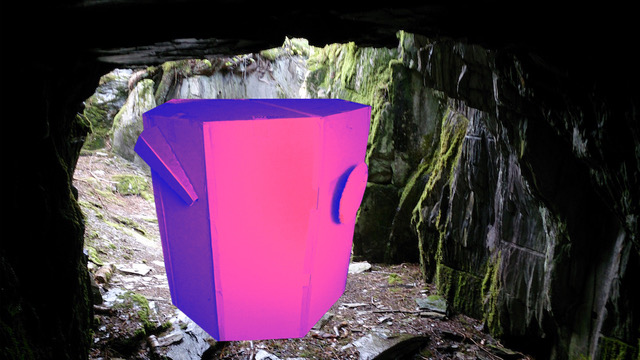
They Are Here
There will be a vegetarian and Halal barbeque on the go, with servings inspired by recipes from the refugees They Are Here have been collaborating with. Food will be offered in exchange for a sketch reimagining the transformation of the garden, this will inform the changes taking place in the Autumn.
Times: DJ 12.00-4.30. BBQ 1.00-4.30
Kathryn Davis, Dhelia Snoussi and Zey Kussan, Museum of London
What might future archaeologist say about us in the park? How right (or wrong!) could they be? Discover the left objects found in park through the Everything project, and see what connections you can make to you, the park and 2019.
Times: 11.00-1.00
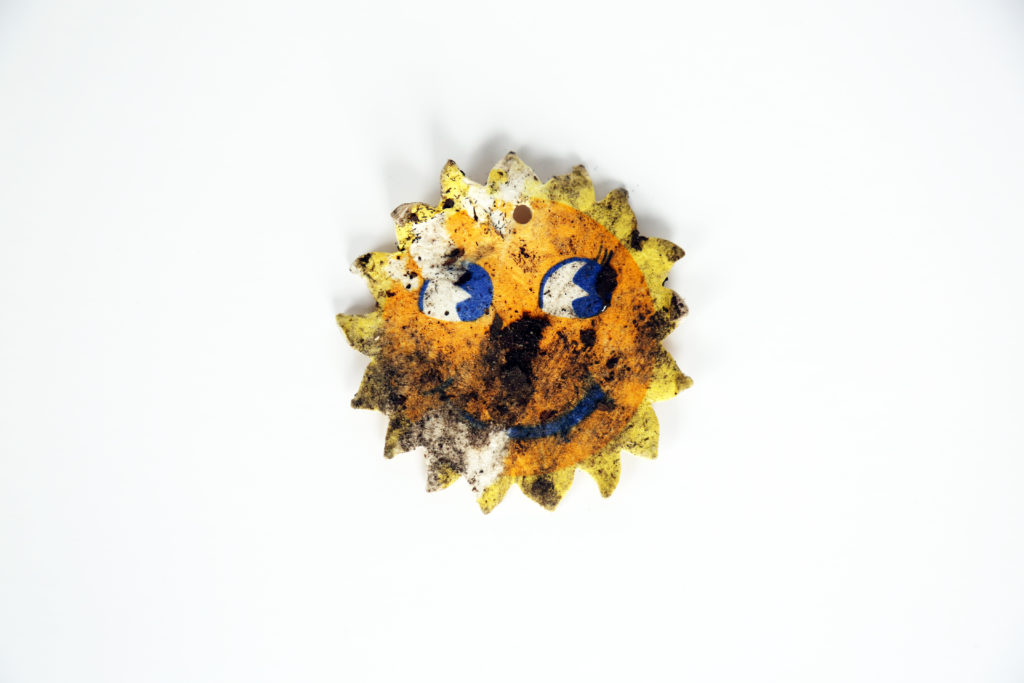
Andrew Smith, Goran Vodicka
Come and map your experiences of Finsbury Park and feed into research about urban parks and festivals.
Times: 10.00-5.00
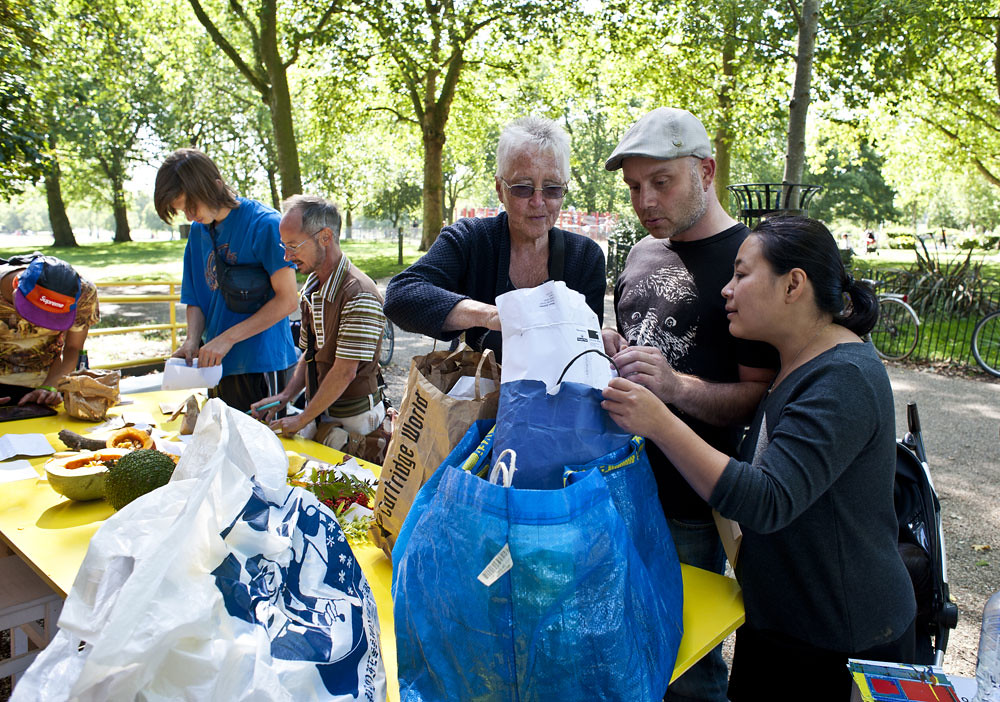
Featured image: Image by Studio Hyte, artwork in image by Jason Wilsher-Mills
Alex Dayo
Alex Dayo is a versatile composer, arranger and musician (he primarily plays percussion instruments), who was born in Burkina Faso, West Africa. Alex recalls growing up to the sound of drumbeats all around him – music has been part of his everyday life from birth, with instruments replacing childhood toys. His professional musical career started in the 1980s, accompanying the National Ballet Kouledafourou on tour as well as playing for African Royalty and globally-recognised dignitaries at private and public events and the Ensemble des Radios and Televisions of Burkina Faso, based in Bobo-Dioulasso. In 1985, Alex founded Fusion band Wountey, and, for fifteen years, toured with his band and the Ballet across Africa and Europe, spreading Burkina Faso’s cultural fusion to a wider audience. His musical collaborations include Ali Farka Toure, Femi Kuti and Salif Keita from Africa and traditional Master Griots from Burkina Faso/Mali/Guinea/Gambia. An accomplished arranger, Alex modifies his style according to the need, incorporating African traditional, Fusion, Jazz, Rock, Latin and Caribbean influences. A highlight of Alex’s career was being chosen to play at the Opening and Closing ceremonies at the London 2012 Olympics. As well as gaining British community music teaching qualifications, Alex developed his teaching skills working throughout Europe (Switzerland, Italy, Germany, Austria, Luxembourg, Belgium, France and Holland) and Africa and has played at numerous festivals and events, including Notting Hill and Hackney Carnivals, where he has performed for the past ten years.
Alistair Gentry
Alistair Gentry is a science fiction artist. He likes silly costumes, museums, absurdity, visiting the uncanny valley, the Oxford comma, and making machines do things their manufacturers wouldn’t approve of. DoxBox trustbot was developed during his embedded research residency at The Open Data Institute. Other recent projects include an imaginary tourist information agency and a technological ritual with televisions and credit card shredders.
Andrew Smith
Andrew Smith is a Reader in the School of Architecture and Cities at the University of Westminster. His background is in urban geography and one of his main research interests is the significance of organised events in post-industrial and entrepreneurial cities.
Goran Vodicka is a Research Fellow in the School of Architecture and Cities at the University of Westminster. He is an architect/urbanist and his research is broadly focused on diversity and inclusion in public spaces.
Feminist Internet
Feminist Internet is a group of artists and designers working to advance online and offline equalities for women and other marginalised groups through creative and critical practice.
Hannah Redler Hawes
Hannah is the director of the Data as Culture art programme at the ODI and an idneoendent curator. She specialises in art and technology, art and science and emerging artistic practice with an interest in participatory process. She develops interdisciplinary projects for galleries, museums, digital space and non-art contexts. Alongside her work with ODI she curates exhibitions, events and art interventions. Past projects have been with Science Gallery London, Tate Modern, Natural History Museum, FACT Liverpool, the Digital Catapult and the Institute of Physics. As an artist, Julie’s focus is the investigation of data as an art material, using it to create work that reflects the human condition through the analysis and representation of data. As a computer scientist and artist, Julie oftens works collaboratively and experimentally with scientists. Her work has been shown widely in the UK and internationally, and she has won awards from the Wellcome Trust, the Arts Council and Nesta. She holds a PhD in Media & Arts Technology from QMUL and is the founder of the Data as Culture art programme at the ODI.
http://culture.theodi.org/about/
Helen Stratford and Idit Nathan
Helen Stratford and Idit Nathan – Working collaboratively as Play Anywhere Now or Never! and combining backgrounds in theatre and architecture, Idit and Helen have worked in partnership with Wysing Arts Centre, Kettles Yard, Cambridge and METAL and in locations across the UK (Bristol, Sunderland, Peterborough, Southend and London). In 2015 they formulated Play The City Now or Never! (PCNN) working with METAL Peterborough and Southend to develop the PCNN App, a site-specific geo-locative App for mobile devices positioned at the intersection of art, play and technology. The PCNN App, like other low-tech resources they have developed, such as a compilation of games and scores as well as DIY die, solicits playful engagement with spaces and sites. Other recent and ongoing collaborative projects include developing a mobile artwork for Yorkshire Sculpture Park as well as walkshops for Cambridge Junction, Festival of Ideas Cambridge, CounterPlay ’16 Aarhus, Wellcome Trust, Live Art Development Agency and the National Theatre.
www.playanywherenowornever.com
Jason Wilsher-Mills
Jason Wilsher-Mills is a disabled digital artist who is based in the East Midlands, using iPads to create paintings which detail his disability, childhood memories, popular culture, social history/heritage, creating new biographical narratives, through theatrical artifice and humour. He initially painted traditionally, with oils, but since becoming disabled has found the iPad screen more manageable – affording him the opportunity to create large pieces of artwork, through high-resolution files, modern Giclée printing methods & projection methods. It has also given him the chance to work collaboratively, due to its connectivity and accessibility. The primary themes of his work include memory, childhood, disability and illness. In parallel to his own artistic practice Wilsher-Mills conducts public art commissions and residencies working primarily with learning disabled collaborators on wild and wacky interactive sculptures.
Larisa Blazic
Larisa Blazic is a London based digital artisan, educator and feminist hacker with practice ranging from net.art to FLOSS art and design. In her most recent work, Data Union Fork, part of Vertigo STARTS Residency, she explores collective response to personal data abuses by state and corporate sector and creates experiments based on technologies developed within the DECODE project and investigates local governance in Local&&Ledger project.
Martin Zeilinger
Martin Zeilinger is a London-based interdisciplinary researcher, curator, and media practitioner. Currently he works as Senior Lecturer in Media at Anglia Ruskin University (Cambridge/UK), and also serves as curator of the Vector Festival (Toronto/CAN). His research interests include digital art, appropriation-based art practices, experimental uses of financial technologies in contemporary art, theories of cultural ownership and intellectual property, political economies of new media, live coding and creative computing, videogame culture, and experimental game art.
Mud Howard
Mud Howard (they/them) is a gender non-conforming poet, performer and activist from the states. mud creates work that explores the intimacy and isolation between queer and trans bodies. mud is a Pushcart Prize nominee. they are currently working on their first full-length novel: a queer and trans memoir full of lies and magic. they were the first annual youth writing fellow for Transfaith in the summer of 2017. their poem “clearing” was selected by Eduardo C. Corral for Sundress Publication’s the Best of the Net 2017. mud is a graduate of the low-res MFA Poetry Program at the IPRC in Portland, OR and holds a Masters in Creative Writing from the University of Westminster. you can find their work in THEM, The Lifted Brow, Foglifter, and Cleaver Magazine. they spend a lot of time scheming both how to survive and not perpetuate toxic masculinity. they love to lip sync, show up to the dance party early and paint their mustache turquoise and gold.
Possible Bodies – Femke Snelting
Femke Snelting works as artist and designer, developing undisciplined research at the intersection of feminisms and free software. In various constellations she explores how digital tools and cultural practices might co-construct each other. She is member of Constant, a non-profit, artist-run association for art and media based in Brussels.
www.snelting.domainepublic.net
Possible Bodies – Helen Pritchard
Helen Pritchard is an artist and researcher, whose interdisciplinary work brings together the fields of Computational Aesthetics, Geography and Feminist TechnoScience. Helen’s practice is both one of writing and making and these two modes mutually inform each other in order to consider the impact of computational practices on our engagement with environments. Helen is the head of Digital Art and a lecturer in Computational Art at Goldsmiths, University of London.
Possible Bodies – Jara Rocha
Jara Rocha is an independent researcher/mediator who tends to attend to the semiotic-material urgencies of present cultures with a trans*feminist sensibility. Works with infrastructural politics and aesthetics, text logistics, body inscriptions and tests non-formal ways of learning in collective situations like Euraca Seminar, Las promesas de los algos, Relearn Summerschool, or The Darmstadt Delegation.
Rachel Jacobs
Rachel Jacobs is an artist, researcher and games designer. She co-founded the artist-led collective Active Ingredient in 1996 and the commercial games company Mudlark Production Company in 2007. She completed a Doctorate in Computer Science in 2014. Rachel is a practising artist exhibiting nationally and internationally, and a Research Associate at the Horizon Digital Economy Institute, University of Nottingham. Her artworks include the award winning ‘Heartlands (Ere Be Dragons)’ one of the first mobile games that took place on city streets in Sao Paulo, Yokhama, Berlin, Paris, Cambridge, Bristol and Nottingham; ‘A Conversation Between Trees’, a touring artwork and schools exchange using environmental sensors to connect forests in the UK and Brazil; and ‘The Prediction Machine’, an interactive installation that predicts the future impacted by climate change. Rachel is currently developing a series of artists interventions ‘Creating Rituals for When The Future Comes’, alongside a mobile interactive artwork the ‘Future Machine’.
Stephen Oram
Stephen Oram writes thought provoking stories that mix science fiction with social comment, mainly in a recognisable near-future. He is one of the writers for SciFutures and, as 2016 Author in Residence at Virtual Futures – described by the Guardian as “the Glastonbury of cyberculture” – he was one of the masterminds behind the new Near-Future Fiction series and continues to be a lead curator. Oram is a member of the Clockhouse London Writers and a member of the Alliance of Independent Authors. He has two published novels: Fluence and Quantum Confessions, and a collection of sci-fi shorts, Eating Robots and Other Stories. As the Author in Residence for Virtual Futures Salons he wrote stories on the new and exciting worlds of neurostimulation, bionic prosthetics and bio-art. These Salons bring together artists, philosophers, cultural theorists, technologists and fiction writers to consider the future of humanity and technology. Recently, his focus has been on collaborating with experts to understand the work that’s going on in neuroscience, artificial intelligence and deep machine learning. From this Oram writes short pieces of near-future science fiction as thought experiments and use them as a starting point for discussion between himself, scientists and the public. Oram is always interested in creating and contributing to debate about potential futures.
Sunara Begum
Originally from Bangladesh, Sunara Begum studied film and fine art in the UK and Yoga and Ayurveda in India. She lives between London and Lagos where she is the co-founder of several international arts initiatives including Chand Aftara, an artist’s collective dedicated to the exhibition and production of experimental cinema, New Horizons Africa, an annual music and arts festival and Living Legacies, Gambia’s first traditional music archive. Begum’s work has been widely exhibited in film festivals, museums, galleries and cinematheques worldwide. In 2017, her film Meditation on Stillness was selected as the Best Experimental Short at the Art Africa Film Festival and the Jury Grand Prize at the 21st Media City Film Festival. Her films are in the permanent collections of Dimbola Museum & Galleries (UK), Lionel Wendt Gallery (Sri Lanka), Centre for Contemporary Art (Nigeria), Drik Gallery (Bangladesh) as well as Central Saint Martins College of Art & Design. Sunara’s work is a highly personal expression of themes including gender, memory and migration with powerful imagery that evokes deep-rooted feelings of reflection, contemplation and stillness. Sunara has developed a visual language that is distinctly her own drawn from her unique lived experience, straddling the dialectics of east and west, cultural identity, femininity and the immutable polarities of displacement.
They Are Here
They Are Here (f. 2006) is a collaborative practice steered by Helen Walker and Harun Morrison. They are currently based in London and on the River Lea. Their work can be read as a series of context specific games. The entry, invitation or participation can be as significant as the game’s conditions and structure. Through these games, they seek to create ephemeral systems and temporary, micro-communities that offer an alternate means of engaging with a situation, history or ideology. In parallel, they initiate multiyear socially engaged projects that become generative spaces for further works. They Are Here work across media and types of site, particularly civic spaces.
Museum of London
Curating London will change how the museum collects 21st century London. It also seeks to recruit staff from a broader range of backgrounds and professional experience and puts Londoners at the heart of our collecting practice by working in partnership with local communities. From physical objects to interviewing Londoners about their own histories and memories, Curating London will capture, collect and record contemporary London.
The project started in April 2018 and runs until March 2022.
Each year the museum will begin four projects: three area studies of particular areas and one themed study that spans the whole of London.
https://www.museumoflondon.org.uk/discover/curating-london-collecting-community-contemporary-city
The exhibition Power and Architecture was created for viewing across several months in a particular sequence. Part 1 focused on Utopia and Modernity (12 June – 3 July), Part 2 on Dead spaces and Ruins, (July 4 – August 10), Part 3 on Citizen activated space — Museum of Skateboarding,(11 August – 11 September), and Part 4 on The afterlives of Modernity — shared values and routines, (15 September – 9 October). A conference held in June – The Centre Cannot Hold? –led by important scholars Michał Murawski (SSEES, UCL) and Jonathan Bach (New School, New York) served to frame the cultural, political, economic ramifications of “centrality and monumentality in 20th century cities” with thought from prominent researchers, architects and artists. Power and Architecture concluded this October as the Calvert 22 Foundation partners with innovative architecture, design and engineering collectives Assemble (UK), Museum of Architecture (UK) and reSITE (CZ) and an Urban Research Mobility Lab connects London with Prague by asking the question: how does migration and mobility in cities affect the experience of the urban environment? A curated series of reports, essays and photo stories further explored the themes of Power and Architecture in the online Calvert Journal available through the gallery website.
Calvert 22 is a gallery devoted to contemporary Eastern European and Russian art. They presented this exhibition as “a season on utopian public space and the quest for new national identities across the post-Soviet world.” I arrived at the gallery, a Californian artist, coincidentally just as I’d read comments from Lev Manovich about the young intelligensia of post-Soviet Russia. Thus, when thinking about the exhibition, I was also thinking about the new global mobile class and the impact of Putin’s Russia upon a new generation.
Power and Architecture is a fascinating collection of research into contemporary art, films, and research about post-Soviet urban identity and the positioning of artists therein. Obviously once communist societies have experienced dramatic change since the fall of the Berlin Wall, collapse of Soviet Russia, and rise of Putin to power. Curators used multiple cultural lenses with which to pry open a critical “western” eye on the aftermath of the Soviet era and invited exploration of cultural narratives about the “post-Soviet” city. The exhibit, particularly in certain places, looked at ideas which appear to have disappeared or become outmoded as a means of aesthetic and political communication. There was an air of longing and self-reflection towards Russian identity when experiencing the work. The Russian people have something to reckon with; a revolutionary utopia which once was, but which is no more and which has left them with the traces of an almost empire,- although to call communist Russian an empire seems to obscure the politics of the revolutionary element-. These juxtapositions were in essence the heart of the show which explored the Soviet Union as constructed space. This ”location” then functions as a backdrop to present-day national identity and urban design emerges in the portrait of a “post-Soviet” society with its own futuristic ideas as well as in the lingering relics of Soviet intentions.
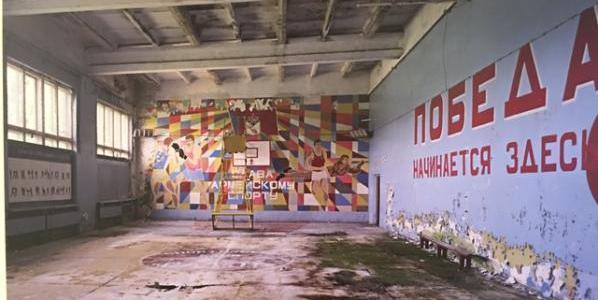
Power and Architecture falls on the heels of Calvert 22’s very successful Red Africa program which examined the cultural, economic and social geography between Africa, Eastern Europe, Russia and related countries during the Cold War. The Eastern European art historical and social trend of the last thirty years labelled ‘self-historicization’ –or the self-conscious effort for Eastern European and Russian artists to articulate, archive, and collect their own history, is exercised throughout the exhibit itself designed in series of presentations directed at the problem of “historical understanding” of history. The post-Soviet city and utopian public space was used as a critical framework from which to position contemporary space, identity and the intent of the exhibiting artists. The Soviet Union has fallen, but who or how is its revising and re-examination taking place?
Part 2 which dealt with “dead spaces”, the architectural ruins of empty cities, military bases, technologial infrastructure and cavernous, open landscapes at once modern and moribund seemed to suggest that retrospective analysis of utopia could only be a well-conceived guess at what was or might have been. This Part was a sojourn into the life of Soviet artifacts both remaindered in their historical trajectory and as a convincing backdrop to a pervasive contemporary ambivalence. Danila Tkachenko’s “Restricted Areas” for instance, was a series of photographs documenting relics of the military build up of the Soviet Union only to be found on abandoned, snow-covered sites in the frozen tundra. Oversized photographs of personal ID cards from unknown persons presumably found amidst Soviet architectural rubble, large format, richly-detailed color photographs of crumbling rooms, weather-worn, orphaned Soviet-era paintings, and peeling, once colorful murals inside Soviet military bases and institutions form an historic record of obvious and shocking lack of preservation of Soviet art and architecture as Russian history. Artists participating in Dead spaces and ruins were Vahram Aghasyan, Anton Ginzburg, and Eric Lusito.
To say that this work engaged narratives which imbue modern mythologies of “utopia” with certain ideas, or contained evidence of the self-conscious effort to bring post-Soviet identity into the picture is an understatement. ‘Utopian’ ideas’ exhibited, situated in urbanism and public space, were the self-conscious investigation of old or familiar‘ or “statist” (maybe) viewpoints on public identity and gave curious attention to questions of truth, experience, voice and historic preservation found in documentary discourse. Self-historicization was apparent in Russian artist Kirill Savchenkov’s Museum of Skateboarding, a mixed media installation, which was its own entire Part 3. Savchenkov’s piece talked about the activation of public space by young people and about skateboarding as a means through which to reflect upon the post-Soviet residential suburbs of Moscow. This work suggests how certain architectural interventions or objects contain meaning and can even be accessed differently or more significantly through subculture. It alluded to tropes in notions of “world” or global “utopia” which translate across seemingly disparate spaces and identities such as Californian and post-Soviet/Soviet Russia. Moreover, this reading of public space as accessed and interpreted by youth is a powerful concept about notions of history and who it belongs to.

In Part 4 (on through Oct. 9) the urban poetics of the post-Soviet city are further contextualized by looking more closely at modernity and everyday life. The afterlives of Modernity — shared values and routines. This Part concluded the exhibit with four artists, Aikaterini Gegisian, Donald Weber, Dmytrij Wulffius, and Ogino Knauss, who examine the “afterlife” of the utopian endeavor, especially the search for new national identity. This theme is provocative to be sure, given the current political contest in the Ukraine and Russia’s role in Syrian conflicts. The curators write:
“Across the former Soviet Union there are a series of architectural and physical nostalgias connecting citizens who share the same socialist history – Part 4 of the programme reflects on these shared values and routines for citizens today.”
I asked myself the question—how does art tie societies together through processes of change? Aikaterini Gegesian’s film, “My Pink City” offers a portrait of a post-Soviet Yeravan in transition and depicts the militarisation of public space and the gendered divisions within the city. In many instances, Russian government has pushed for laws “designed to rid Ukraine’s public spaces of communist relics. Their destruction proclaims a deep desire to change the cultural narrative.” In Part 2 many documentary photographs of “dead” Soviet relics are a poignant record, and politically at odds with ideas at play in contemporary Russian national consciousness. It is a record which rightfully belongs to the Russian and Ukrainian people and which makes this show more meaningful when thought of as the struggle to preserve the past for the future.“Monumental Propaganda”, a series by Donald Weber documenting sites where Soviet monuments stood and the empty pedestals remain, speaks to exactly this. Dmytrij Wulffius’ “Traces on Concrete” is a series of photographs taken from 2009 and 2013 of his own hometown, Yalta in Crimea, which also explore its architectural landscape from the perspective of modern youth. “Re:centering Periphery: Post Socialist Triplicities” by Ogino Knauss is a fascinating examination of post-socialist history in Berlin, Belgrade, and Moscow, three cities in which modernity triggered profound utopianism towards the “radical transformation of the everyday.” The piece looks at “what is left of the architectural vision in the cities and what this legacy leaves to citizens”.

Power and Architecture aimed at a present-day coming to terms with a particular Russian existence now broken into segments and pieces. It focused profoundly on the precarity and erasure of history which plagues 21st century thought on so many levels.The real and the fake, the true and false, the meanings of “Soviet utopian vision” and its presence in time in architectural and artistic form. Without quite melding together as what that vision was in the political sense, the show formed a quasi-science fictional narrative and interpretation; a history of place, both real and imagined; promised and denied.
Central to the visual collection and comprehension of these ideas was, curiously, the strategy of the archive where the act of collection takes place and where the borders and edges of history are possible. By focusing upon the urban environment of the Soviet Union now past, Power and Architecture asked us to consider ‘what modernity is” in this context. If it is machine aesthetics as James Bridle (2011) suggests, then which machines have contributed and how do we use this modern aesthetic position on technology to examine a past? If it is the new aesthetic to be looking at old relics with a different lens, then what intellectual “spin” is constructed? For whom, how, and for what? Maybe modernity is all of these—a presence of unprecedented scale in terms of cities, and the sky and the water. How do we see this totality now? How did they see it then?
Modernity did come upon Eastern Europe and Russia, arguably in similar and dissimilar ways to how it was absorbed in the west. Power and Architecture re-examined the Soviet epoch, through what artists are seeing and thinking about what has remained. It seemed expressed as a brute emergence of a set of ideas which, because they were collective, revolutionary, technological, shaped and still shape Russian consciousness, but as a past. How the past is preserved or ingested is again a compelling idea on the power-struggles for “history” which take place in modern times. Power and Architecture elucidated key features of this new era of global subjectivity and societal change through creative lenses of the recent past.
Roger Malina is a physicist and astronomer, Executive Editor of Leonardo Publications (The M.I.T. Press), and Distinguished Chair of Arts and Technology at the University of Texas at Dallas. Dr. Malina helped found IMéRA (Institut méditerranéen de recherches avancées), a Marseille-based institution nurturing collaboration between the arts and sciences.
Mariateresa Sartori and Bryan Connell are two artists recently based at IMéRA. Their work connects with human movement through the city, and addresses the intersection between technology and perception. Recent work by Venice-based Mariateresa Sartori has encompassed drawing and video. Bryan Connell, Exhibit/Project Developer at San Francisco’s Exploratorium, works especially with landscape observation devices and mapping.
Lawrence Bird interviewed Roger Malina, Mariateresa Sartori, and Bryan Connell about the intersection of their work with the city. Images above courtesy: Roger Malina, Rita Gambardella, Bryan Connell.
Lawrence Bird: Roger Malina, in your recent writing you make the case that science is no longer just a field of positive knowledge. Scientists are increasingly open to engagement with the arts — for example artists’ residencies at CERN. You’ve even argued that we’re in a crisis of representation as profound as that of the Renaissance or the 19th century, and this is “driving a new theatricalisation of science.”
Urban life has often been understood as performative – display, performance of social roles, presentation of oneself before others are all part of the public life in cities. How would you say that crisis of representation plays out with regards to this performative dimension of urban life? How is science implicated alongside art in the city, in these conditions?
Roger Malina: One of my arguments for the ‘crisis of representation’ really looks at Renaissance systems of representation — first driven by what the eye could see, and then the eye extended by microscopes and telescopes. These systems of representation were developed that led to a deep contextualising of the viewer in the world.
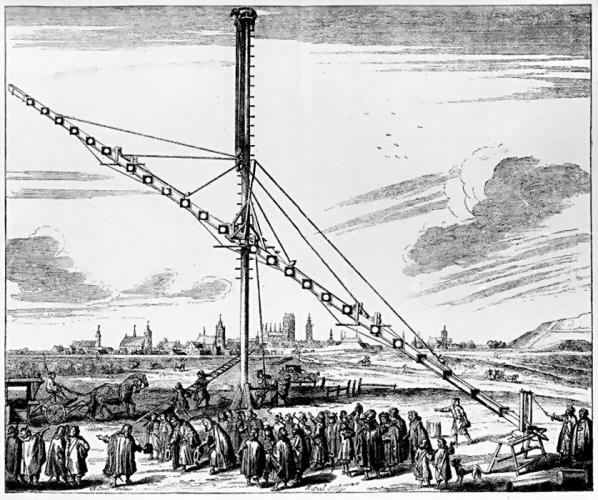
Today we are in a new situation because so much of our perception of the world comes not through extended senses but, in a real way, through new senses. This has been happening over a number of decades; the first wave of this was at the end of the 19th century when there was a cultural shock with the introduction of x-ray images, infra-red and later radio — which didn’t extend existing senses but augmented them.The most recent series of triggers maybe comes from the nano-sciences and synthetic biology — we now perceive phenomena of which we have no daily experience of (eg quantum phenomena). Field emission microsopy or MRI or some of the other new forms of imaging really don’t build on our existing experience — there are discontinuities and dislocations. Another element is of course the hand held device that leads to techniques for ‘augmented reality’ — I have a phone app that I can point at an aeroplane overhead and it tells me what the plane is, where it came from, and where it is going.
Coming to your question about the city — there is clearly a shift in map construction and reading — from the Cartesian map that we have been acculturated to. The ability to toggle between the bird’s eye view and the “street view”, and the ability to view maps that have multiple layers simultaneously are driving artists and others to develop new forms of representation.
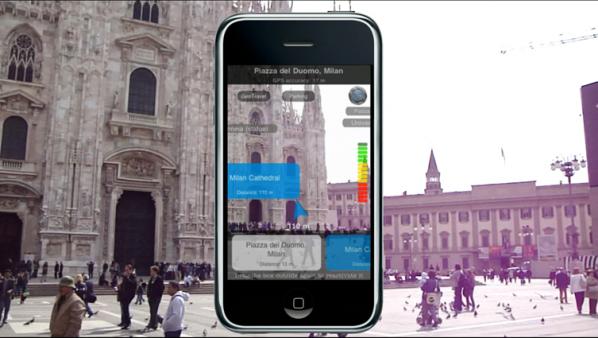
Someone whose work is interesting in this regard is Bryan Connell in San Francisco, he just finished an art science residency at IMéRA in Marseille. He was working on a large urban trail project called GR13 — 300 miles through industrial, urban, sub urban, and wild landscapes (the city had a hell of a time getting right of way through these areas). Bryan is currently working on a web site for the Marseille European City of Culture events, where he’s working on some of these questions of representation. The project involves a collective of ‘artist-walkers’ that I think fits right into this question of performativity.

LB: There’s currently a great deal of interest in the connections between representation, digital technology, and politics, for example the current Hybrid City II conference in Athens. As you’ve pointed out, these often underline the connections between what digital media mean for artists and what they can contribute to citizens — what’s emancipatory about them. What can art offer civil life in this context? Are there any conflicts or contradictions in that relationship?
RM: One pertinent example is the work of Bruno Giorgini, a physicist, and Mariateresa Sartori (visual artist) who work on the “physics of the city.” They were recently in residence in the IMéRA Mediterranean Institute of Advanced Study which hosts artists and scientists in residence who want to work with each other. We now have access to incredible amounts of data on human mobility (pedestrian and various forms of transportation) so it is now possible to study human behaviour quantitatively. Sartori discovered that she could tell many things about a person just through the morphology or topology of their movements through the city. Girogini discovered that people’s movements could be predicted at the 80% level, but 20% of the time he had to introduce what he called ‘social temperature’; in discussions he also referred to this as a ‘free will’ parameter. Barabasi has found similar results analysing cell phone GPS data of individuals. So its interesting to think of the development of cities as 80% predictable and 20% serendipitous. This of course then highlights the role of the arts and culture in making cities part of the cultural imaginary that drives people to make choices. Recently Max Schich here at the University of Texas has analysed very large data bases looking at where prominent people are born and where they die over the last 500 years. Immediately you can see how suddenly certain cities become cultural ‘attractors,’ say the way Berlin or Hong Kong are now. And of course cities are now trying to ‘design’ this into the development of cities. Here in Dallas there has been a huge investment in the ‘arts district’ and in institutions of higher learning in the belief that healthy cities require such investments. See for instance the US National Endowment for the Arts Program; there are many similar programs in Europe.
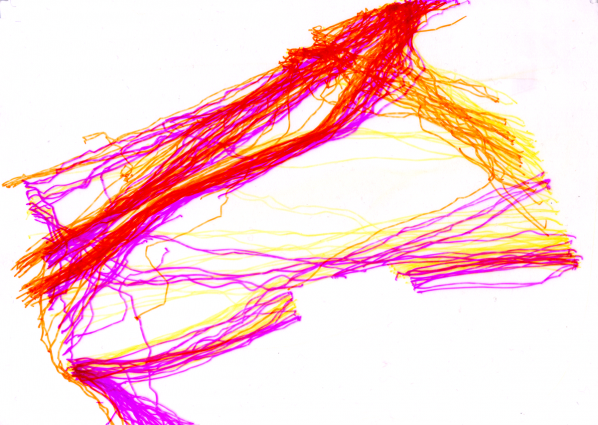
This doesn’t yet address your ’emancipation’ question. One of the things that is happening is that we are becoming a data taking culture (see the recent literature on ‘big data”). The cell phone has transformed every citizen (that has one) into a data taker. Of course much of this data is used by companies for marketing objectives. But many citizen groups are now able to take data for their social objectives. Some of this is captured by the ‘citizen science’ movement ( one example is here). There have been good examples of citizen’s taking data (on pollution, on illegal activities etc.) and then being in a position to challenge ‘authorities’ of various kinds whether scientific, political or economic (see for instance the way citizen groups have mobilised to collect data after man-made disasters such as oil spills, or illegal logging in forests).
A few years ago I wrote an open data manifesto which argued that I would like to advance a new human right and a human obligation:
1. Each of us has the right to the data that has been collected about ourselves and our own environment.
2. Each of must contribute to the knowledge construction by collecting and interpreting data about our own world.
Most scientific data collection is funded by public tax payer funding. The public has a fundamental right to all data collected and funded by public tax money.
LB: How do you imagine an artist’s training will change as these conditions evolve? And a scientist’s — could we foresee any kind of convergence?
RM: One interesting development is a cohort of hybrids, who have one degree in science or engineering and one in art and design ( for example J.F. Lapointe, a researcher at the National Research Council of Canada with degrees in molecular biology and dance) or degrees in Science or engineering and employment in art or design (like myself or Paul Fishwick, a key figure in the field of aesthetic computing). There’s been an emergence of art/science Ph. D. programs that take students from art or design or science or engineering. I suspect this cohort will grow over the coming years.
LB: Mariateresa Sartori, your IMéRA research project with Bruno Giorgini focused on mobility in the city. Can you tell us a little bit about how your work and Dr. Giorgini’s work complemented each other? What kind of evidence did you bring to the table as an artist?
MS: The project I worked on with Bruno Giorgini developed an exploration that began with earlier work in Venice. There I created a series of drawings using a rudimentary, even crude procedure: I traced out the movements of each pedestrian in the Piazza San Marco, drawing their paths with a felt-tipped pen on a transparent sheet placed over the computer monitor. I then faithfully transferred the results onto ordinary large sheets of white paper. The lines thus drawn in different directions created a space, drawing a St. Mark’s Square that is actually not there. As well as the actual physical space, it is also a drawing of our individual and collective manner of relating to space. Each single path determines the route of others, in a continuous and reciprocal game of influences that makes our collective progress.
At IMERA we developed this method for a new environment, a city more ethnically and culturally plural than Venice. Together we set up procedures and tools for collecting data about mobility networks there: nodes, links, chronotopi. These drew on the work of Bruno Giogini’s Laboratorio di Fisica della Città of the University of Bologna. We shot videos focusing on specific behavioural patterns where strategies of shifting, approaching and distancing play a decisive role; and we were also attracted by the places and situations of pedestrian congestion. Using the same technique as in Venice, I translated these into drawings of movement. These again created a space that marks out squares and places which are actually not there, each synthesizing space, time and humanity in a single image.

LB: Is there an emancipatory or governance-related dimension to this work? Degrees of mobility have human rights implications. How does your work as an artist connect with these rights, especially the notion of the right to the city?
MS: The first goal when I work as an artist observing reality is observation, i.e. a way of observing that implies a new attention. The result is always instructive because I do not have particular expectations. After lines have been traced following my process, something always emerges and what emerges can be a useful and indicative element for the emancipatory dimension of the urban condition. I would say that Bruno Giorgini is more involved in that dimension than me, especially in the notion of the right to the city.
LB: There’s a current preoccupation among researchers in a number of fields with the relationship between representation, often engaged with/through technology, and urban life. How has your latest work connected with this relationship?
MS: My way of working with technological instruments such as computers is very particular and limited. I use the computer as a technical tool strongly mediated by the senses, i.e. by human perception. I am very interested in modalities of perception: they are so imperfect, yet sufficiently perfect to make our existence possible.
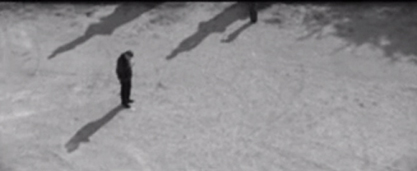
LB: You described the way you work with technological instruments as “particular and limited.” Another way to look at this is that you make the technological system slow down by inserting yourself into the process… and the result is your drawings, which still movement. Might this be one role for art — to insert the human into the machine? Much net art focuses on flows of information, virtual movement, and representing that. While not quite glitch art, do your representations of movement in some sense intentionally put a brake on the machinery?
MS: I find your words enlightening, you describe my way of working better than me….. Actually I insert myself into the technological process…..but this is not a statement of a position against technology.
I can say that what interests me the most (and art’s relation to science is just one instance of this) is the thread of connection between specific cases and general theory, between subjective and objective. Between, on the one hand, the singularity of events and, on the other, general theory. The individual’s experience is singular, unique; but there is always a thread, even if fine, that leads each individual case to a wider generalisation. What interests me is this incessant – indispensable as much as concealed – mental activity that every day leads us to search for generalisations and regulating principles. What interests me is the human tendency to comprehend phenomena, even the most complex, via schematic representation, via a generalisation that leads to the identification of organising principles. I mean “Comprehension” in very wide sense, where emotions and feelings participate too in embracing reality, including reality. Maybe in this sense I put the human in the machine…
There is a discrepancy between how we perceive reality, mediated by our senses, and the truth decreed by science. On a rational level we recognize the truth, but we cannot internalize in a deep way this knowledge; this is beyond our human capabilities. I think that in my artistic research I find myself in this deep discrepancy.
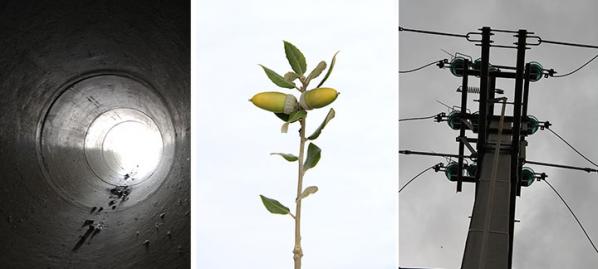
LB: Bryan Connell, your work in Marseille addresses, among other concerns, technology and its relationship to nature. Do you see the urban environment as playing any particular role in that relationship — of having a particular status in our negotiation of it?
Bryan Connell: One of the things that intrigued me about the metropolitan hiking trail in Marseille is the way it plays with our sense of meaning and value in the exploration of contemporary landscapes. Most long distance hiking trails are designed to lead out of urban environments, not into them. We don’t usually think of carrying a field guide that illustrates the taxonomy of fire hydrants, electrical pylons, or urban weeds on an extended city or suburban walk. That kind of engaged, systematic attention is usually reserved for wild natural terrains. From a traditional environmental perspective, the less altered a place is by human technology, the more scientifically interesting, ecologically exemplary, and aesthetically rich it’s going to be. Without undermining the validity of ever-present environmental concerns, the trail functions as an invitation into a more challenging and complex relationship to the emerging para-wilds and novel ecosystems that are arising at the intersection of the natural world and the technological infrastructure of the built environment.
Similarly, the Marseille trail doesn’t really focus on the kinds of urban sites that are traditionally thought of as having significant historic, architectural, or cultural interest. Instead, the trail route incites visitors into an exploration of the everyday environments and working landscapes of the contemporary urban transect – a world of parking lots, freeway overpasses, suburban developments, abandoned railways, and semi-rural wildlands.

Landscape ecologist Earl Ellis argues that to better navigate our way through the current geohistorical epoch, the Anthropocence, we must expand the traditional ecological concept of regional biomes into the parallel notion of “anthromes” – biomes that are complex interconnected melds of human technology and natural systems. In a sense, the GR 2013 Marseille trail is a sketch or system of exploratory paths into what a publically accessible, anthrome based urban ecology observatory might look like.
LB: A similar question is in relation to the image, especially sequential images. What does it mean for our negotiation of the relationship between nature and technology? Between science and art?
BC: We increasingly live in a networked digital metropolis with an image and information density that both mirrors and exceeds the high population densities of the physical metropolis. One topic of particular interest to me is the role these images play in transfiguring the quality of our desire. To what extent do scientific or aesthetic images that increase our ability to find meaning and satisfaction in observing and understanding urban landscape phenomena mitigate our need to physically alter the landscape to conform to an idealized image of what it should or shouldn’t be?
For example, the Marseille metropolitan trail didn’t require much physical alteration of the terrain – it’s a conceptually designated network of pre-existing roads, paths, streets and highways. The trail’s function is not to alter place, but alter the cognitive landscape of trail users so they have a richer sense of place. If you are fascinated by the diversity of ways a para-wild plant population has adapted to a technologically modified environment, do you need to engage in an energy and material intensive re-landscaping of that environment with a palette of conventional horticultural plantings to make it more “beautiful”? In this sense, constructing interpretive images of landscape is more than a way of augmenting a recreational hiking experience, it’s a way of shifting and re-configuring what we think we have to consume and alter to find meaning and vitality in contemporary landscapes.
http://uranus.media.uoa.gr/hc2/
Hybrid City is an international biennial event dedicated to exploring the emergent character of the city and the potential transformative shift of the urban condition, as a result of ongoing developments in information and communication technologies (ICTs) and of their integration in the urban physical context. After the successful homonymous symposium in 2011, the second edition of Hybrid City has grown into a peer reviewed conference, aiming to promote dialogue and knowledge exchange among experts drawn from academia, as well as artists, designers, researchers, advocates, stakeholders and decision makers, actively involved in addressing questions on the nature of the technologically mediated urban activity and experience.
The Hybrid City 2013 events also include an online exhibition and workshops, relevant to the theme
Hybrid City Conference 2013: Subtle rEvolutions will take place on 23-25 of May 2013.
The Hybrid City II events will take place at the central building of the National and Kapodistrian University of Athens.
This document was edited with the instant web content composer. Use the online HTML editor tools to convert the documents for your website.
Featured image: corporations are not people – the Overpass Light Brigade
Overpass Light Brigade in Tosa from Overpass Light Brigade on Vimeo.
Wisconsin has arguably been ground zero for union busting, DIY social movements, corporate takeover of government, and divisive – and often misinformed – political debate in the US for more than a year. And the Overpass Light Brigade (OLB), initiated by Milwaukee artists Lane Hall and Lisa Moline, have been a guiding light – literally – in how ground-up messaging and change can happen. Now a collaboration between many people, the OLB relies on an ever-widening community of activists, artists, thinkers, and do-ers for their “Signs of Resistance.” After a few rounds of local rye whiskey at Milwaukee’s Riverwest Public House Cooperative – one of the only co-op bars in the country – I did an email back and forth with OLB co-founder Lane Hall to find out more about what makes them tick, how they see themselves, and where the movement they are a part of is headed.
Nathaniel Stern: What is OLB? It feels more “struggle-” rather than “goal-” orientated, despite that its first mainstream recognition is in relation to a specific campaign. Can you talk a bit about its history: how it started, where it headed, and what it might become?
Lane Hall / Overpass Light Brigade (OLB): On November 15 of last year a rally was organized by grassroots groups in Wisconsin in order to kick off the Recall Walker campaign. It was to begin right after work, at 5:00 pm. Both Lisa Moline (co-founder of OLB) and I had been very active in what we now think of as the Wisconsin Uprising, and we asked ourselves the simple question, “How do we achieve visibility for graphic messages when it is dark at 4:30?” We began to tinker with off-the-shelf Christmas lights, and found some battery-powered strings of LEDs. We built our first sign, a 3′ x4′ panel that spelled out RECALL WALKER. When we arrived at the rally, we were immediately asked to be behind the speakers. That sign got on the Rachel Maddow and Ed Schultz show that evening, so we knew we had hit on something that afforded powerful visibility. That first sign is now, incidentally, in the archive of the Wisconsin State Historical Society.
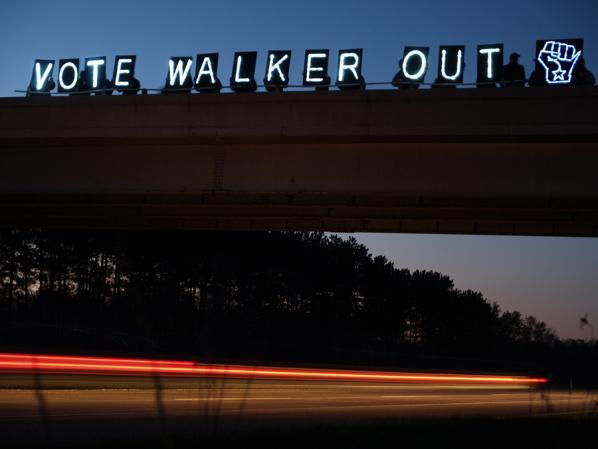
We then proposed a second design challenge to ourselves: how do we get messages out to masses of people, since we can’t command the airwaves like Walker’s Koch-fueled campaign? Once we decided to go out on highway overpasses, we “scaled-up” the letters so that we could spell out words, refrigerator magnet style, one letter per 2′ x 3′ placard.
Our first night out was on an overpass in South Milwaukee. It was very cold, fairly miserable really, with freezing winds kicking up from the passing semi-trucks. We had a few fellow activists to help, and our idea was to bungee-cord the signs to the fence while we stood by. We were accosted by a right-wing nut, a Young Republican, who was vehement in his insistence that we were breaking the law by affixing the signs to the fencing. He ended up in a physical altercation with Lisa in his insistence to rip our signs off the fence as well as forcefully take Lisa’s video camera, since she was capturing his vigilante actions on video. When the police came, they did reiterate that nothing could be affixed to the bridges, though also supported our right to be there. From that night on, we realized that for OLB to work, we needed Holders of the Lights – one person per letter, as well as “spotters” for safety and a couple of people to take video and photos. This was a profound tweak of the original idea, in that it shifted our actions from mere signage to a form of witness or testimonial. It is very powerful to see one person per placard, positioned high above the highway, committed to the politics of physical presence.
We began to go out around the area, scoping out different overpasses, hooking up with different grassroots groups in Madison and Racine and Kenosha and Milwaukee. For about two months we took out RECALL to various locations, often getting hassled by people, questioned by cops, pushed to defend our rights to be out in these odd public spaces. We began to add letters and attract more volunteers who were attracted to our strange mix of Fluxus happening and focused message. RECALL WALKER, then 1% WALKER, then JOHN DOE (referring to an ongoing investigation into alleged campaign corruption when Walker was Milwaukee County Executive), then WALKER=JOBS FAIL and WALKER LIES and WALKER IS A CROOK, etc. We have always tried to index the message to what is breaking in the broader mediascape, so that there is resonance between multiple layers of information and our activist response.
Once Walker was officially recalled (he was “recalled to election”) things really picked up. We were getting invited to hold actions around the state – Madison, Fond du Lac, Portage, Appleton, Kenosha, Racine – and more and more people began to join us. The 2 hour overpass occupations began to take on a real festive quality, with people bringing food, making music, chatting, singing, chanting and enjoying the angry and happy honks from the freeway. Our messages expanded, and our Bridge Parties have become somewhat legendary, with anywhere between 40 and 120 people commonly showing up. We even have a bagpiper who often leads us on and off the overpass.
A big part of the success of OLB is its mediagenic quality. Photographs and videos have been distributed freely and widely, at times even virally. We’ve been highlighted in the NY Times, CNN, Time Magazine, the Milwaukee Journal Sentinel, countless blogs and Facebook sites too numerous to even itemize. Our Facebook “reach” was hitting 182,000, and I was getting constant queries about the project. Our community of activists is extremely diverse, which is one of the things I am most appreciative of. It is odd how powerful holding a sign over a highway is, how many conversations happen in the two hours of bearing witness, and how compelling the action remains for our volunteers.
We immediately went out the night after the disappointing results of the recall. I felt that what I call “essential visibility” was even more important for the progressive community. WE SHALL OVERCOME and SOLIDARITY FOREVER graced the bridges, and we subsequently began to help some striking workers in Milwaukee pizza factory with BOYCOTT PALERMO’S. Since the recall, I feel we have gotten stronger and deeper, no longer relying on the easy binary of our disaffection towards our tea-bagger governor. Our issues are bigger and broader, more national. We just went out in Madison with CORPORATIONS ≠ PEOPLE and 56 volunteers showed up, along with some projector-shine activists, live-streamers, and a phalanx of videographers. We have also taken out QUESTION AUSTERITY and are integrating it with a social media #questionausterity campaign. I see the synthesis of physical and virtual space as the future of OLB actions, as well as our growing ties with the Occupy movement.
NS: This is more than inventive campaigning or even creative activism, but protest art with heavy political, aesthetic, ethical, and technological implications. The Graffiti Research Lab was first to use high technology to ask, “Can any public space be a blackboard?” You take that as given, provide the chalk, and ask for important messages to be broadcast on said blackboards. I’d like for the both of you to write a bit about your practice as artists, as activists, where they are one and the same, and where sometimes they differ.
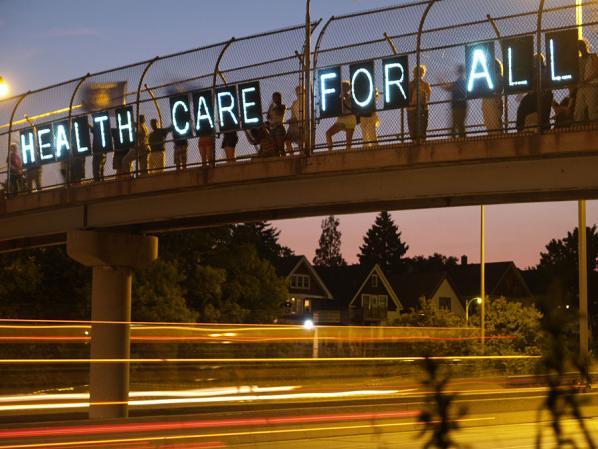
OLB: The Graffiti Research Lab is a continued inspiration for us in terms of their open-source ethos, and their bold pushing at the “public” aspect of “public space.” I have great admiration for what they accomplished, yet have always felt frustrated that their messages generally stayed within existential parameters. That is, their presence in urban space was implicitly political, but their projections were generally, “I exist” with variations on the theme such as “Fuck you!” However, the way their events brought people together in the streets is also noteworthy. OLB has achieved some of these same dynamics, though with very directed and explicit political messaging. We are a fluid mix of relational aesthetic, Fluxus happening, street party and progressive messaging, all part of an inherently ethical practice. We think of ourselves as “the people’s bandwidth,” having found an open venue that takes a lot of dedication but only a small outlay of capitol, which is intrinsically public to thousands of passersby.
Our own work has been collaborative for a long time. Before the Wisconsin Uprising, our art – often about environmental issues and animal subjects – was implicitly political, but rarely pushed the boundaries of sanctified institutional spaces. Once the Uprising began, we got very involved with activist work, and took our creative efforts to the streets. We were inspired, set up a PAC called The Playground Legends with some other activists, and began working within some of Milwaukee’s African American communities on voter education and Get Out The Vote campaigns. We set up “parties in the parks” for neighborhood groups, and used these relational activities to help create cohesion around a political purpose. This was exhausting and finally not sustainable for us, but some larger groups such as Wisconsin Jobs Now emulated our inventiveness and have really made a difference in spite of the Right’s coordinated campaigns of disenfranchisement.
After working with this PAC, and struggling with the official requirements of a 501C3 and meetings with minutes and budgets and fundraising and reports, we chose to make OLB as flexible and open as possible. We are a loose affiliation of activists who show up on bridges and hold signs. It is very simple. Anyone can join. All ideas are welcome for consideration. Our community of activists is really the heart and key to sustainability with OLB. Most of them don’t care whether this is art, or what the cultural precedents might be. All of them value this odd form of engagement, where they can see a beautiful and directed message reflected back through social media, and be a part of a much larger – and historical – emergence of a progressive political movement.
NS: Who do you want to follow your lead? Who do you want to help OLB progress to more innovative interventions? How can we help you help us?
OLB: We freely share the instructions for making the signs. They are very easy in concept, very DIY, and need only basic wood shop fabrication skills, akin to stretching canvasses or making a woodcut print. However, each sign does take a lot of concentrated construction, which can discourage some who have wanted to create their own. So far, we have 3 different chapters that have taken to the bridges: OLB-Fox Valley, OLB-Dane County (both in WI) and OLB-Harrisburg. We’ve also seen other iterations, such as a Madison based “Sign Brigade” doing daytime roadside actions. I see that OLB has a function as a model of empowerment, as well as the joy (or anger) one gets from seeing a message “done up in lights.” One thing that hasn’t happened yet is an ongoing series of “hacks” that extend and expand the idea. The off-the-shelf lights get expensive. Could someone figure out how to make battery powered (not big battery + inverter, but lightweight AA batteries) LED light strings so that we could build our own? How about other variations? This would be great to see, especially now that the Graffiti Research Lab’s open inquiry with LEDs seems a thing of the past.
NS: What have been some favorite moments from the bridges?
It always amazes me when some random stranger pulls off the highway and comes to find us. Sometimes, especially at first, this would mean trouble, in that aggressors would want to direct anger at us. But one night in the bitter cold weather of January, an African American man came up to the bridge, told us he saw us and wanted to give us a gift, and offered each Holder a beautiful knit hat. He was a salesman of sports clothes, and had a lot of hats. We each left that night with a new Milwaukee Bucks hat!
Another time, just a few weeks ago, two women – an older woman and her adult daughter – came up to the overpass. Both were public school teachers. The teachers have been so demonized in Wisconsin – it is both ridiculous and shameful, but it obviously works to divide us, and as obviously takes its emotional toll on these new “enemies of the state.” The older woman exclaimed that they were “so grateful to see us out there doing this” and she burst into tears. There were lots of hugs and they hung around for awhile, held a couple of letters, and left. It was very moving, as a lot of our Holders are themselves teachers.
We also hosted the famous “Nuns on the Bus” tour – the politically progressive group of Sisters who are going around the midwest to decry the austerity budgets of Paul Ryan and the Republicans. It was amazing when their bus pulled up by the overpass, and these elderly activists (along with the powerful Sister Simone) approached the bridge and saw the QUESTION AUSTERITY message we had created just for their tour. There were 96 people on the bridge that night, and they all sang happy birthday to one of the Sisters since it was her 72nd celebration that day. That was a wonderful event, and a great example of diverse activist communities coming together based on these joyful actions.
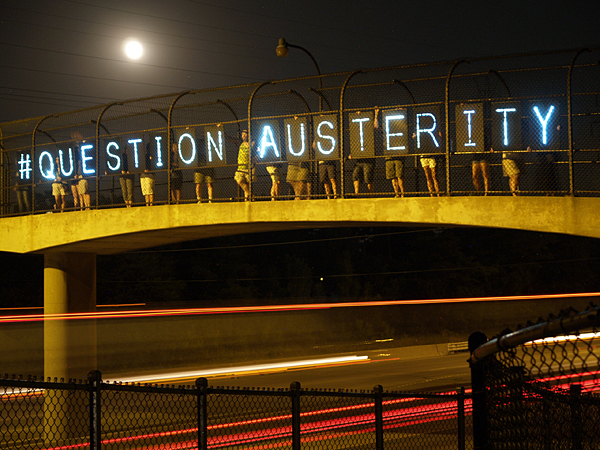
I could go on and on. Each action, each Bridge Party, is a whole narrative – interactions with police, with passersby, with neighbors both supportive and critical, and now and then with aggressors who have busted out our car windows or tried to shut us down. But it is all powerful, all a microcosm of the rifts in our country. The bridge is a forceful metaphor beyond its commanding physical presence over the geospatial distribution network function of our highways. It works both linguistically and architecturally, and affords a curious perch for our loose affiliation of committed brigadiers.
NS: How can we make our own stuff?
OLB: Check out our new site at http://overpasslightbrigade.org/
You can also find “noise of rain” posts on the Daily Kos site
http://www.dailykos.com/user/noise%20of%20rain
Featured image: “All Hail Damien Hirst!”, Tamiko Thiel, 2012. Turbine Hall, Tate Modern, London.
Interest in Damien Hirst and his commercialized, celebrity status is well known. So when we heard that Tamiko Thiel was making the artwork “All Hail Damien Hirst!”, we were immediately curious. Hirst is an extremely rich individual with powerful allies within wealthy, traditional art establishment circles. This includes Charles Saatchi, and commercially dedicated art mags and art institutions whom have all successfully helped in marketing his particular brand as part of their own economic strategy. With this in mind and acknowledging the potential risk in satirizing a well known art celebrity we thought it was a good idea to interview Thiel about her ideas and experience on the project?
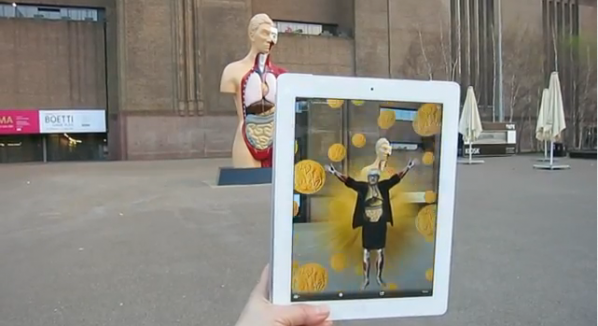
MG: Many are curious about your new augmented reality project “All Hail Damien Hirst!”. It is an art installation and intervention. Why have you chosen to create an artwork aimed specifically at him, during his retrospective exhibition at the Tate Modern?
Tamiko Thiel: As a visual artist my projects start with having a strong image in my mind’s eye that compels me to pursue the project further. When I heard of the retrospective at the Tate I immediately had an image of Hirst – depicted in a style relating to his own working methods – hovering in the vast space of the Tate Modern Turbine Hall. On findng out that the space was not going to be used except for the small room housing his diamond skull, I saw an opportunity to give visitors an experience that would utilize the space beautifully, compliment his own work and bring the contradictory feelings that many have about him and his work into sharper focus.
In my own work I often draw on the power of religious imagery. This aspect of Hirst’s work, and also his themes of the body and death, are very compelling to me. On the other hand, he plays a master hand at making the art market dance to his tune. I find the market value of his carefully ordered spot paintings, for example, in marked contrast to the artistic power of Yayoi Kusama’s spot obsessions, which were exhibited probably not by coincidence at the same time at the Tate Modern.
To top it off, while flipping through a United Airlines onboard magazine I chanced upon an image depicting the value of Hirst’s artworks as an exaggerated – and spotted – version of the movement of the stock market:

I wanted to make a work that addressed multiple issues surrounding Hirst as a person, as an artist and as a force in the art market at a time of extreme tension in the world’s financial markets. I knew however that Hirst is very litigious, so I was careful to use none of Hirst’s actual artworks, so I do not infringe on his copyright!
I had done an earlier augmented reality work, Reign of Gold, as part of the AR Occupy Wall Street project. In this work, viewers all over the world can chose the site at which to view the piece on their smartphones, and then see an animated rain of gold coins superimposed over the live camera view of their surroundings. I have photos of this work against the New York Stock Exchange, the Bank of England in London, TEPCO in Tokyo – the company that brought us the Fukushima nuclear disaster – and other choice sites around the world. You will see a clear visual relationship between the rain of gold coins and Hirst’s spot paintings, which many say are destined to go through a similar boom and bust cycle as are the world financial markets.
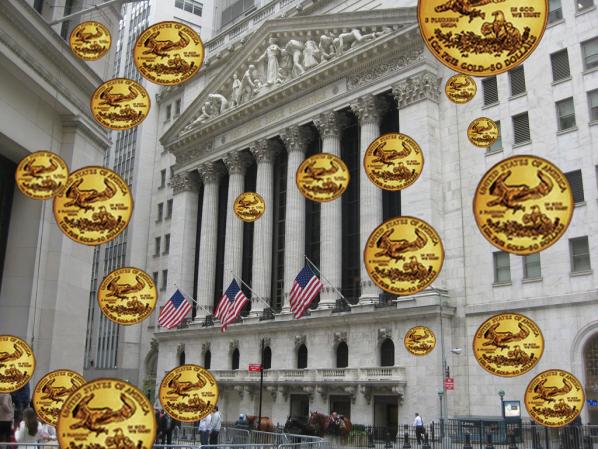
If I was a painter I would’ve gone off and made a painting, and that would have been the end of that. Since I work with augmented reality however I could place the image in and around the Tate Modern itself, the very site of Hirst’s exhibition. This puts a whole different spin on the artwork, as having an artwork “in” a prominent arts venue is seen as a form of “canonization” in the art world, even if the artist places the work there by him- or herself, as did Banksy.
This brought in yet another level to the project, as the work functions now not only visually, but by dint of its location also questions the system by which the art world consecrates artists and artworks. What does the location of an artwork mean, if every artist decides for herself where to place the work? Walls cannot keep us out, nor can walls keep us in. Even Hirst, who is known as a control freak, cannot exercise control over augmented reality.
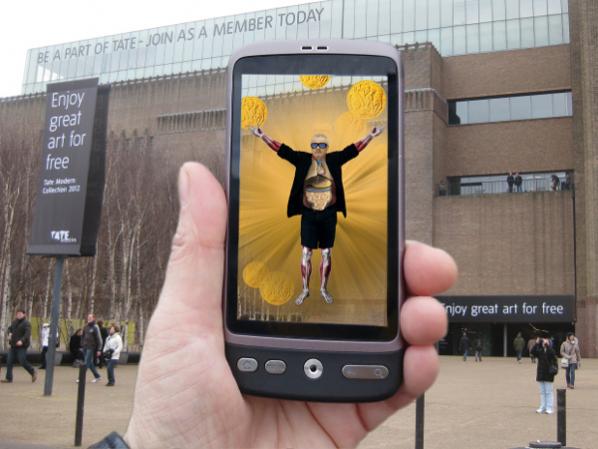
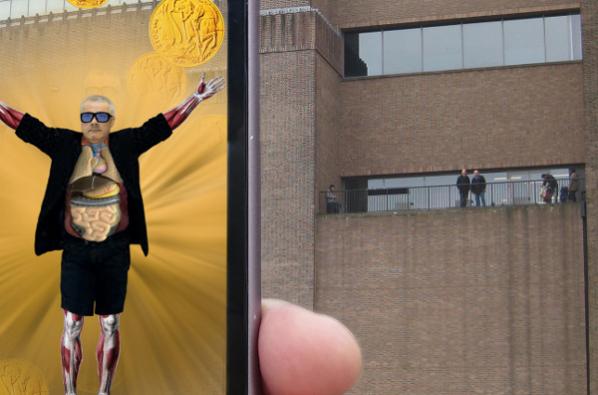
MG: You visited the Tate Modern and interacted with the public. What kind of responses did you receive by visitors to the intervention?
TT: Delight! Most had come to see Hirst’s exhibit with contradictory feelings about the man and his art because of similar issues to those that had motivated me to make my artwork originally. They were delighted at how my artwork spoke to these feelings while leaving the conclusion open for the viewer. They liked the spatiality of the piece, how it surrounded them and filled the cavernous empty space of the Turbine Hall when viewed inside the Tate Modern, and reflected on Hirst’s “Hymn” sculpture when viewed outside by the river. There was also fascination about this new technology which none had ever seen before, and of course some puzzlement about how it worked.
MG: What message are you hoping to communicate with this interventionist project?
TT: What attracts my attention as an artist are topics that provoke contradictory or unresolved emotions in myself. By their very nature I can’t answer these topics with a simple message. Instead I try to create striking images and visual/kinesthetic experiences that evoke the contradictory feelings I have myself, in the hopes that my works can help focus or sharpen the issue, or at least provoke dialog in those who view them.
To cite a different work from my art practice: even in “Shades of Absence,” in which I surround anonymous golden silhouettes of censored artists with terms of censorship, I am myself of two minds about many of the artworks I cite in the linked website on censored artists. I made Shades of Absence as an intervention into the 2011 Venice Biennale, at a time when Ai Wei Wei was imprisoned by his own government. In his case I am strictly against the censorship of him as an artist and a person, but in many other cases I have cited, I myself could not say I would always be against censorship when it could incite hate and physical violence against others.
MG: Is it mainly Hirst you are critiquing here or is he representative of something bigger in art and its culture that you are questioning?
Hirst is the British Jeff Koons! Every era and every country finds such a figure to represent the eternal tension between art as a sublime personal experience and art as the magnet for glamour and status and money. I wonder if it was any different for the artists of the cave paintings?
MG: In the publicity for the project, it says ‘Augmented Reality is the Street Art of the 21st Century!’. Could you elaborate what this means to you, and share with us some examples of other interesting works in this field?
TT: In this regard, to be frank I think the work of my cyberartist collective Manifest.AR is the leading work in the field at this moment, perhaps because we are all so diverse and cross-fertilize each other!
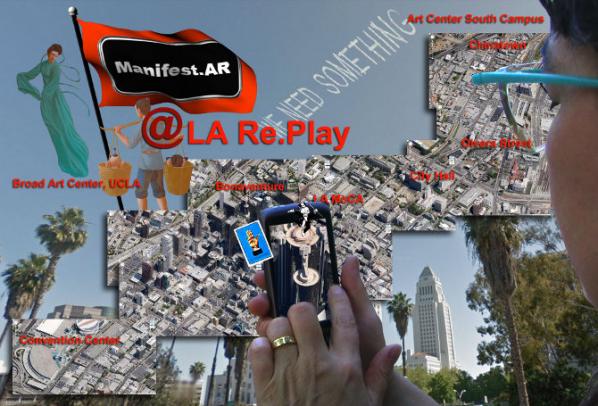
Of course augmented reality is not as visible as a graffiti on the side of a building – but it also cannot be removed, and we can place them wherever we want without fear – yet – of arrest or fines. Also, the smartphone or mobile tablet is becoming an extension of the self, and our primary interface with the extensive virtual society in which we are embedded. It is how we will communicate, how we will find information, how we will share our social space with everyone who is not standing in exactly the same room at exactly the same time, it will become our entertainment device, our payment device and god forbid our identification device. You do not go to someone’s house to look through their photo album, you go to their Facebook site. Why shouldn’t you start finding their thoughts and expressions as augmented reality images around you in space?
I just successfully co-wrote a major Rockefeller Foundation grant to help residents of a very poor area of a major city put up their own history and artwork in their neighborhood using augmented reality. I can’t say much about it as the official publicity has not yet been released, but the organization I wrote it for is convinced that in a couple of years, more of their youth will look at art on smartphones than in museums and art galleries. Will the middle and upper classes lag behind, because they think the only art worthy of note is hanging on gallery walls?
All Hail Damien Hirst! An augmented reality installation celebrating Damien Hirst at the Tate Modern.
http://www.allhaildamienhirst.com/
“Reign of Gold” – part of AR Occupy Wall Street
http://www.mission-base.com/tamiko/AR/reign-of-gold.html
Tamiko Thiel – Online Portfolio
http://www.mission-base.com/tamiko/
Tamiko Thiel is a media artist developing the dramatic and poetic capabilities of various forms of virtual and augmented reality as media for exploring social and cultural issues.
A founding member of the cyberartist group Manifest.AR, she participated in the pathbreaking augmented reality exhibit “We AR in MoMA,” an uninvited guerilla takeover of MoMA New York. Videos of Thiel’s “Art Critic Face Matrix” were featured in articles in the New York Times and on WNYC (National Public Radio). In 2011 she led the Manifest.AR Venice Biennial AR Intervention, placing her work series “Shades of Absence,” on censorship in the visual arts, in the Venice Giardini and in the German National Pavilion (which won the Golden Lion Award for best national pavilion). This led to an invitation to participate in the ISEA2011 exhibition UNCONTAINABLE, an official parallel program of the Istanbul Biennial, where she placed her artwork series “Captured Images” into the main biennial exhibition
In February 2012 Furtherfield is opening a public gallery at McKenzie Pavilion in Finsbury Park, providing space for exhibitions, activities and events for art, technology and social change. Before we officially open we would like to invite local community groups and organisations to join us in a friendly networking event which we hope will be the first of many, leading to fruitful partnerships and collaborations.
Inviting Local community groups!
During the event, you will…
– Meet up, be seen, show what you do
– Get to know other organisations and discuss ways we can collaborate
– Inform Furtherfield as to what can happen in the space
We are living through times of great change and uncertainty. Over the next 18 months, Furtherfield hopes to provide a space for imaginative exchange between artists – international and local, of all ages and backgrounds – on epic and everyday themes. Our success depends on the quality of our conversations. We hope that this event will be the first of many that will lead to fruitful partnerships and collaborations. We are inviting local organisations and groups involved in the arts, education, community engagement and support, and all of those working in and running activities in the park.
A full list of confirmed guests will be made available at the event. Please tell us about people or organisations who are important to our area and or who might want to come along and get involved.
Refreshments will be provided.
Please RSVP to Alessandra Scapin, Furtherfield Programme Manager and Coordinator, on ale[at]furtherfield.org to confirm your attendance as the pavilion has limited capacity or on 020 8802 2827 (please leave a message – we are not always in the office)
For more information about getting to the gallery http://www.furtherfield.org/gallery/visit
Liz Filardi is a New York City-based performance artist who often works in public space. She was recently awarded a Turbulence Commission for a networked performance piece called I’m Not Stalking You; I’m Socializing, exploring the anxieties of social networking in three modules. “Status Grabber,” the first module, is a satirical online service that extends the status update phenomenon to participation over the telephone. “Black & White,” the second module, is a Facebook-like website, consisting of two interlinked profiles, that tells the story behind one of the original cases of criminal stalking in America. “Facetbook,” the final module, is a performance piece in which the artist compiles a series of archives of her live Facebook profile to illustrate the tension of online identity– between the façade of a profile and the more telling story of how the profile changes over time. The interview was conducted by Taina Bucher, PhD fellow in the Department of Media and Communication at the University of Oslo, Norway. Bucher and Filardi met in Greenwich Village, New York City in May, 2010.
Taina Bucher: How prominently do your friends feature in your work?
Liz Filardi: Well, my only “in” to a social network like Facebook is my own profile, my own network. I think I have about 900 friends. I could start over with a new profile, but I would still only be able to access people that I know or know of. So the people who participate in works based in existing networks, like “Facetbook,” are my friends, and in this context, that includes any Facebook “friend” who feels comfortable commenting or interacting with me. I suppose there is also a subset of “friends” who are made aware of my activity without necessarily caring or wanting to interact with me. In that respect, networked performance on Facebook is very much like performing in public space—I get ignored a lot.
But I would love to find a way to reach a completely different audience on a social network, ideally a subset of users who have stumbled upon my profile without really knowing me or maybe only knowing me from the context of the network because I’m a “friend” of someone who they have “friended.” I have been thinking about starting over on a network like Facebook with this goal in mind, just to see what is possible. It would also be fun to create a new profile controlled by a collective of artists who want to play and experiment.
Why not just make a group on Facebook?
Groups have limitations. Individuals have the most access and mobility on Facebook, because it is designed with the individual’s activity in mind. Groups are like, “I’m here, come over here,” while individuals can say, “I like this, I am doing this, you and I are friends,” which is obviously what drives the site. I am also more compelled by putting a face on a group and speaking from the first person, mixing individual voices and sensibilities and presenting that as one person. It feels a little more subversive. I am interested in playing with the expectations of “friends” on Facebook. For some reason, there is a lot of trust that everyone, that is every non-celebrity, is exactly who they say they are.
Can you tell us a little about your project “Status Grabber?”
“Status Grabber” was created as a satire on the obsession with status updates. I wanted to know how people would react to a telephone-based service that essentially mimicked the way people use Twitter. So I called people and told them that someone they knew had anonymously requested a status update, and that they should provide me with a brief statement that I could post to the internet. I set up a website where people could actually make those requests and hear the responses. But I also made cold calls to random people listed in the telephone book.

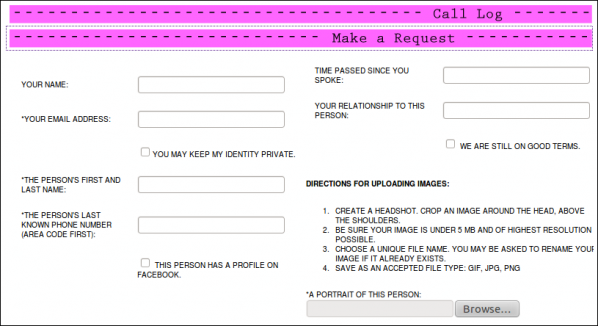
My interest in status updates lies in the disconnect between the author’s intention and the follower’s intention as they engaged in a fairly consistent relationship mediated by a service like Twitter. On Twitter, you can post one message immediately visible to your followers, and those people can discover something about you and experience the feeling of a connection without ever having to say a word or reciprocate. In fact, as you post your update, you often do so with a vague idea of audience, not necessarily of personal connection. So the relationship between a Twitter author and follower can feel smug, but it is artificial—it is a designed experience. Apparently, if popular social tools fill a vacuum of desire, as we often believe, people actually prefer this designed experience on some level. We tend to prioritize the feeling of a connection over the actual value of the connection. In making the calls for “Status Grabber,” I’m basically confronting people with this cultural value.
I visited the site and listened to the call records you posted. It seems that people don’t have a clue about the notion of status updates.
Yeah, the concept of a status update obviously doesn’t translate to the telephone. On the phone, there is much more opportunity to communicate beyond the 140 characters allowed in a Twitter status update, so that became a humorous limitation to the updates that people were encouraged to provide. As a totally believable service, Status Grabber suggests that people actually do not want to have a full conversation or hear a complete update on your status, but instead prefer the abridged version so they can get on with their lives. Of course, most of the call recipients seemed slightly disappointed or appalled for that reason, and in that way, it felt like a good prank phone call.
Call recipients that were willing to participate seemed to feel anxious about the pressure of submitting a status update verbally. They were on the spot to say something substantial or witty as if posting to their Twitter or Facebook account. Most of the updates reflect more spontaneity, less density than can be read in Twitter feeds. I often felt that I was invading their privacy to demand a status update by telephone.
Let us jump to your third module “Facetbook.” How did you come up with the idea?
My day job is in design and I work with the content management system and blog software WordPress. When you edit a blog entry, a new entry is simply added to the database like an appendix to the original entry, so that you’re never editing the existing content of the database but merely adding to it. There is an archive of all your revisions. I started to imagine Facebook having a similar structure. It is possible that we are creating an archive of our life just by being active users, and yet, we have no ownership or access to it. Meanwhile, we present a singular identity within the construct of the profile. We update our profiles to project an idealized representation of ourselves. But if anyone could see the archive of these profiles and be privy to how they have evolved over the years, they would get a much more accurate sense of who we are, and maybe they would be able to see that truth far more clearly than we ourselves can see it.
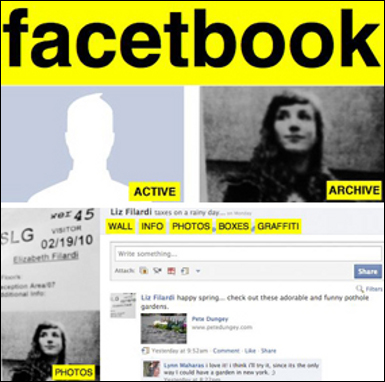
With that in mind, I started to imagine that Facebook actually provides a literal construct of identity. Is this why it’s so addictive and popular? It’s not as if we can go back in time in real life and see written archives of every conversation we have had with friends, and every song we quoted in high school, and every trend we followed. We understand our own identities based on our memories and the occasional ephemera- diaries, photographs, videos, concert tickets, old clothes. In some senses, we don’t own our past, but only the precious ephemera. And in the space between the ephemera and reality, we get to imagine our own story. On Facebook, we can flip back through our activity and photos, and we construct our profiles based on how we see ourselves and who we would like to be. But we can never see old profiles, ones that we’ve since replaced, or content that we’ve removed. We get to curate our identity, manage the expectations of “friends” and find privacy by hiding behind the content we chose to share. That feels real.
And yet, there is something distinctly unreal about Facebook, which is that it is essentially a document, a record in and of itself. Facebook users live on a document. What if everything ever deleted, in fact, lived on? That makes me anxious. So I started looking for software that would allow me to archive my Facebook profile, and I found an experimental Firefox plugin developed by a group of computer scientists at Old Dominion and Harding University. Using their plugin, I started to archive my profile every time I wanted to change it. I wanted to see what it would be like to own an archive—to at least know what it would contain, even if I couldn’t control what Facebook did with my content.
The truth was that I was far more invested in my image and my Facebook life when I was in college than I am today. Maybe it would have been more insightful to capture that early period. But ultimately, the “Facetbook” performance became about investing in Facebook again and thinking about the stakes of participation. Knowing that I would be creating this archive and could delete my profile at any time, I tried to confront the extent of how people actually use Facebook. I wrote things like, “For brief periods of time, I have favorite profiles that I like to check,” and “even if you never change your profile, I will look at the same three pictures more than once. It gives my mind something to work with.” It feels strange to perform on a site where only a very acute mix of authenticity and performance is acceptable as a voice—you know, in posting status updates that display some charming aspect of yourself without exposing that you’ve given any thought to it. With “Facetbook,” I’m trying to expose Facebook as a site that serves a more libidinal function for people.
How do you see performance art changing in an environment where performance has, to some degree, become commonplace?
That’s a bold statement—one could argue that public life has always been about performance and that performance is no more commonplace today than in the past—but maybe it is more commonplace. The prominence of the social web—especially for younger generations who have restricted access in the real world—pushes public life online and into the realm of performance. People who are growing up with social networks are justifiably feeling like the center of the world with daily evidence to that effect. The lives of prominent, young YouTube vloggers are filled with connections to near strangers who make up coveted audiences across geographic boundaries. Any time someone has an audience, they become a performer. I think of Natalie Bookchin’s Testament, which is a multi-channel video essay that appropriates YouTube vlogs to speak to themes like work, economy, and war. The video diaries that are used in her piece exemplify a personal, confessional approach as seen in television shows like The Real World, and yet they are beyond television—these people are acutely aware that they are sharing their daily life not necessarily with friends but with an audience. The vloggers use common buzzwords and phrases that Bookchin pulls out to create the sensation that they are speaking in unison, just as news anchors and talk show hosts speak in an established language and tone. And that has become a normative way to socialize.
But performance art is entirely different from the spirit of performance on the social web. For one thing, the moment you disseminate over the internet or design your work for an internet based reception, you are creating media art, or networked performance, as Turbulence has preferred to call it. As far as my own experience with performance art, every time I perform something in public, I imagine being interpreted in two camps: an amateur throwback to the founding artists like Abramovic and Ono and Shneemann (young performance artists always seem so nostalgic for the power of the body and the live act, but it’s rare to pull off something powerful and new) and/or an urban prankster looking for attention in the local paper or city blog (a la the clever performance troupes like Improv Everywhere who disrupt city life with the exciting treat of surrealism). So I think the challenge for contemporary performance art is to find a place that is at once culturally relevant and striking, and to champion public space in a compelling way. It’s too easy to just take your actions to the streets of New York like plop art. People are already used to that. Lately I’ve been trying to create works that don’t come across as one-liners, but instead inspire the viewer to question what is going on, or to hold on to one particularly poignant affect or visual. The last thing I want to say—it gets problematic when one begins to qualify performance art as something that happens in galleries and museums because it was meant to defy the commodification of art, but I do want to say that I see it forging ahead in small galleries like Recess in SoHo.
Can you speak a little about your second module, “Black & White?” How did that come about?
That project started with research into the history of criminal stalking, as it relates to the popular contemporary idea of “Facebook stalking.” I wanted to explore the relationship between the tongue and cheek use of the word stalking to describe fairly typical activity on social networks and historical accounts of serious stalking in a time less saturated by social web technologies. I was fascinated by a famous case from 1988 between two co-workers at a Silicon Valley software engineering company. A young woman, a 22 or 23 years old Laura Black, started working at the company as one of the few female engineers. She sparked the unhealthy interest of a male engineer, Richard Farley, who became suddenly deeply obsessed with her. He stalked her for years, and while she sought help at her company when she feared for her life, she had trouble getting any real protection. She changed addresses and phone numbers, which only provided temporary relief, and got a temporary, ineffective restraining order. He would send letters, arrive at her house unannounced, and once joined her gym. In her anger and fear, it seems that she also wanted to show him that he couldn’t control her and that she was still going to enjoy her life and stay in the area. So there really wasn’t a collective intelligence about the threat of stalking at the time. Farley eventually arrived at the office with an arsenal of weapons and attacked the entire company. Black was shot in the shoulder and survived. Farley was arrested. Shortly after, the first anti-stalking law passed in California in 1989 and the story, along with a couple of other violent stalking cases, made national news.
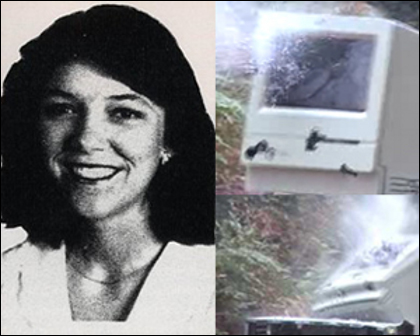
Today, we don’t hear about cases like that because we have a lot more information and legislation to prevent that kind of thing. I can only assume that potential incidents are resolved before escalating to that level. We live in a different climate, where we share a lot more information about ourselves on the social web, and “stalking” is a hyperbolic term that describes the ultimately harmless activity of focusing on the available information of a single person without their knowledge or consent. The use of negative hyperbolic terms like “stalking” indicates a safer cultural climate, but also a latent guilt that may be rooted in cases such as the one illustrated in “Black & White.”
This makes me think of Twitter and the term “followers.”
Yes, it’s similar. Perhaps there’s a greater cultural need to be leader, with a collection of commoditized “followers” in tow. On the social web, we are less often ordinary humans and more often celebrities or actors splintered by various interests and audiences.
In “Black & White,” why do you transpose the stalking case into the paradigm of a social network?
Black&White is the name of a fictional network that looks much like Facebook, but it only contains two members: Laura Black and Richard Farley. Creating this site was a way to call attention to collective intelligence, to speak the language that we (on Facebook) have all learned so well. I knew that most people would intuitively be able to navigate the format and learn the story between the two people involved. In the context of the vast network of Facebook, it is striking that there are only two people in this network. Their content is linked through their job and location, despite their apparent lack of friendship. Underneath the relatively unassuming public profiles is a horrifying, one-sided correspondence in their message in- and outboxes. I wanted to dramatize their loneliness and emphasize the lack of will in their connection, which is how they will be remembered in the American collective consciousness. Hopefully this leads viewers to consider how and why the term “stalking” or the act of “stalking” has changed since the 1980s.
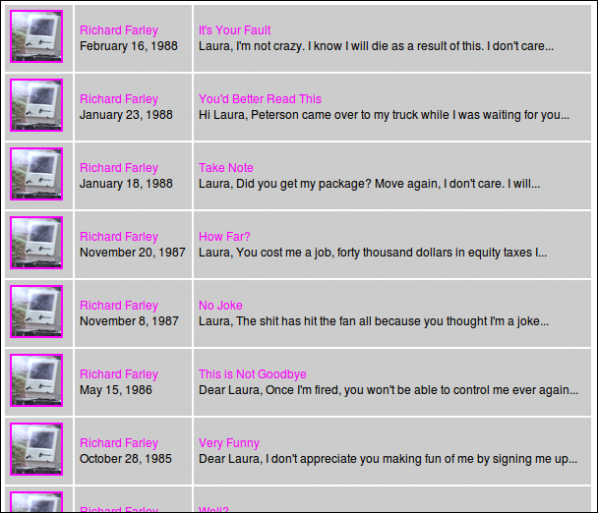
In terms of creativity on social networks, I think a lot of us are just filling in forms. The template of the social network is limiting. Will this have any affect on the direction of your work?
That’s a good question. I have felt confined by the structure of social networks, and even with the content of art that speaks directly to social networks. With I’m Not Stalking You; I’m Socializing, I started with the easiest form of art made to respond to social networks: a satire perpetrated through mimicry in other medias or dimensions, as seen in “Status Grabber.” This has been done in other works, as well. I guess I needed to make that piece so that I could see what was beyond it, and I believe I went a little further and yielded more insight in the other two modules. But now I’m starting to see how the social web simply permeates our consciousness and I believe I may find more insight if I take a step back from art on social networks altogether. As someone who has grown up on social networks, I’m interested to see how the themes that I’ve honed in my work with social networks will surface and return in works and areas of practice that move in a new direction.